
Climate-related risks and
accounting
April 2024

Climate-related risks and accounting April 2024
Contents
1
Executive summary 2
1 Introduction 5
2 Conceptual and methodological considerations 10
2.1 The boundaries of financial reporting 10
2.2 Climate-related risks, accounting and financial stability 12
3 Main issues identified 17
3.1 The extent to which market prices incorporate climate-related risks 17
3.2 The valuation of non-financial assets and liabilities 20
3.3 The incorporation of climate factors into models 24
Box 1 ECB observations on climate change in expected credit losses 24
3.4 Disclosures 27
4 Conclusions and policy discussion 29
References 33
Annex 1: Work on climate-related risks by ESMA in its role as coordinator of accounting
enforcers 36
European Common Enforcement Priorities 36
ECEP assessment 37
Report titled “The heat is on: disclosures of climate-related matters in the financial
statements” 39
Next steps 39
Annex 2: ESRS E1 Climate change 41
Annex 3: IFRS accounting standards and the main issues identified 45
Imprint and acknowlegements 46
Contents

Climate-related risks and accounting April 2024
Executive summary
2
This report analyses how climate-related risks are addressed in International Financial Reporting
Standards (IFRS) and reflected in financial statements prepared in accordance with those
standards, all from a financial stability perspective. It considers ongoing work by the IFRS
Foundation, the European Commission and the European Securities and Markets Authority
(ESMA). The report does not, however, discuss sustainability standards (e.g., the European
Sustainability Reporting Standards or those issued by the International Sustainability Standards
Board), except where they relate to connectivity.
Climate-related risks can affect accounting, as well as the relevance, reliability and materiality of
the information disclosed in the financial statements. The impacts of climate-related risks should be
included in the financial statements to the extent that the recognition criteria set out in IFRS
accounting standards are met – only in that case will the economic events and transactions
carrying those risks result in an asset, liability, income or expense, gain or loss being reported in
the financial statements. For this reason, financial statements may not always be able to fully
capture the impacts of climate-related risks on a reporting entity’s financial position, results and
risks. In particular, financial statements may not adequately reflect (i) risks that materialise beyond
the time horizon over which the entity expects to derive economic benefits from its assets and cash
outflows to settle its liabilities, and (ii) the future actions that an entity may be compelled to take in
order to mitigate and address climate-related risks and to operate as a going concern. In this
regard, prevailing uncertainty about the future impact and timing of the materialisation of climate-
related risks is an important factor to consider when assessing the extent to which accounting
should reflect such risks.
Although accounting is not primarily meant to foster financial stability, there are at least three
channels of transmission: (i) transparency, (ii) behavioural response of economic agents to
accounting information, and (iii) regulation (as accounting is either the starting point or key
reference point when defining prudential requirements for regulated financial institutions).
Accounting for climate-related risks could affect financial stability through any or all of these three
channels. Moreover, while financial institutions have only limited direct exposure to climate-related
risks, their interactions with the real economy (i.e., through loans, insurance contracts or holdings of
securities) indirectly expose them to climate-related risks. The way in which non-financial
corporations include climate-related risks in their financial information may also raise financial
stability concerns.
With these considerations in mind, the European Systemic Risk Board (ESRB) has assessed how
climate-related risks are addressed in existing IFRS accounting standards and reflected in financial
statements, identifying four relevant issues for financial stability:
1. The incomplete incorporation of climate-related risks in market prices can cause assets to be
overestimated or liabilities to be underestimated, affecting both financial institutions (mainly
through holdings of financial assets) and non-financial corporations (particularly through
tangible assets measured at fair value, such as investment property). The expectation would
be for market prices to gradually incorporate climate-related factors, as the transition to a low-
Executive summary

Climate-related risks and accounting April 2024
Executive summary
3
carbon economy unfolds and as the uncertainty surrounding the physical impacts of climate
change dissipates. However, a scenario of sudden adjustment cannot be completely ruled out.
For instance, this could occur in the event of a sudden and disorderly transition, or due to non-
linearities and the sudden manifestation of the physical impacts of climate change. In any
case, having climate-related risks reflected in the market price of assets is an issue that goes
beyond the accounting realm and should be addressed by appropriate policy tools.
1
2. The effect of climate-related risks on the initial and subsequent valuation of non-financial
assets and liabilities, including property, plant and equipment, intangibles, goodwill, provisions
and off-balance sheet items (e.g., contingent liabilities). Failing to fully include relevant climate-
related risks in impairment tests for non-financial assets may distort their valuation, affecting
non-financial corporations and, indirectly, the financial sector through their exposures thereto.
As a case in point nowadays, failure to adequately consider climate-related risks when valuing
real estate, which plays an important role as collateral in bank lending, could affect financial
stability in the event of sudden value adjustments. Moreover, non-financial corporations
operating in certain sectors may fail to adequately report climate-related liabilities due to the
prevailing uncertainty about the future financial impacts of these risks, among other factors.
3. The incorporation of climate factors into the models used to estimate expected credit losses
under IFRS 9 Financial Instruments or expected cash flows from insurance contracts according
to IFRS 17 Insurance Contracts. It may be operationally difficult for banks and insurance
corporations to incorporate climate-related risks into their models, as they would need to
frequently collect, review and update reliable and sufficiently granular sustainability data.
Furthermore, in the case of catastrophe risks and insurance corporations, relying excessively
on past data could lead to inaccurate estimates of insurance liabilities.
4. Disclosures. Efforts should be made to enhance disclosure requirements about how climate-
related risks are reflected in the financial statements. Even if IFRS accounting standards
contain implicit requirements to disclose relevant information on climate-related risks, those
requirements may go unnoticed and become ineffective, particularly if driven by a strong
judgemental component. This puts the onus on enforcing appropriate interpretation and
application of IFRS accounting standards. Furthermore, expanding the existing disclosure
requirements without due consideration of the underlying estimates and data sources could
have unintended consequences.
The four issues identified ultimately relate to the existing uncertainty about the materialisation of
climate-related risks. They also show that climate-related risks are viewed differently among
stakeholders and reveal a lack of commonly accepted and sound methodologies for estimating their
financial impact. This increases the risk of delayed recognition of climate-related risks in the
financial statements, which could in turn lead to “information shocks” if sudden changes must be
made to the financial statements as expectations are abruptly reassessed, potentially damaging
financial stability via fire sales, higher cost of capital and suboptimal allocation of resources. Even if
outside the accounting realm, further work should be carried out on methodologies to objectively
1
See, among others, European Central Bank and European Systemic Risk Board (2022 and 2023).

Climate-related risks and accounting April 2024
Executive summary
4
gauge the impact of climate-related risks, in order to ensure comparability and aggregation of the
impacts disclosed by individual institutions.
The ESRB has considered possible actions related to the design and implementation of IFRS
accounting standards that could be beneficial for the timely and accurate incorporation of climate-
related risks into the financial statements.
2
With regards to their design, IFRS accounting standards generally allow an entity to reflect climate-
related risks in the financial statements, within the boundaries of financial reporting. However,
several amendments could prove beneficial for users of such financial information and, indirectly,
for financial stability. These amendments relate to (i) the application of the materiality principle
under IAS 1; (ii) the addition of climate factors to the list of indicators of impairment under IAS 36;
(iii) how IAS 37 should be applied in view of climate-related-risks; and (iv) disclosure requirements,
examples and guidance on how climate-related risks should be incorporated into the estimation of
expected credit losses and the fair value of financial instruments (affecting IFRS 7 and IFRS 13).
Work on the accounting treatment of pollutant-pricing (i.e., carbon-pricing) mechanisms should also
be prioritised.
Turning to the implementation of IFRS accounting standards, regulators, microprudential
supervisors and/or accounting enforcers should consider developing guidance on disclosures by
financial institutions, on how climate-related risks can affect the expected credit loss estimates of
banks, and on how to compute cash flows from insurance contracts directly exposed to climate
factors (including natural catastrophe events and home insurance in areas most affected by
climate). Disclosure would be another area warranting further attention by regulators,
microprudential supervisors and/or accounting enforcers.
Given the boundaries of accounting, sustainability standards are crucial when it comes to disclosing
the long-term financial impacts of climate-related risks. The entry into force of sustainability
standards will not have the intended effects if reporting entities do not properly connect
sustainability information with financial information in their financial statements. Insufficient
connectivity can lead to duplications and divergent disclosures under financial and sustainability
reporting, and, more broadly, deteriorate the quality of the information disclosed to capital markets,
with potential consequences for financial stability. To avoid such an undesirable scenario, further
work in this area by the respective standard-setters would be welcome.
Last but not least, the scope of the assurance work carried out by auditors is crucial in this regard.
Auditors can play an important role, particularly when assessing existing disclosures and
challenging estimates affected by climate-related risks. Furthermore, ensuring that sustainability
reporting (including transition plans) is subject to assurance work as part of statutory audits could
be a valuable tool in addressing the lack of connectivity between accounting and sustainability
standards. Work by the International Auditing and Assurance Standards Board at the global level
and by the Committee of European Audit Oversight Bodies at the EU level is a first step towards
equipping auditors with a common approach to the assurance of sustainability information.
2
The term “implementation” should not be interpreted in connection with Regulation (EC) No 1606/2002 of the European
Parliament and of the Council of 19 July 2002 on the application of international accounting standards, but rather in the
traditional sense of the process of putting a decision or plan into effect.

Climate-related risks and accounting April 2024
Introduction
5
In recent years, the European Systemic Risk Board (ESRB) has been analysing accounting
issues that could affect financial stability, with a strong focus on their macroprudential
policy implications. Starting in 2017 with the publication of a report commissioned by the
European Parliament on the financial stability implications of IFRS 9 Financial Instruments,
3
the
ESRB has been analysing the expected credit loss approach under IFRS 9, the macroprudential
implications of financial instruments at fair value classified under Levels 2 and 3, and IFRS 17
Insurance Contracts.
4
These publications provide evidence of the interaction between accounting
and financial stability.
In this report, the ESRB analyses how climate-related risks are addressed in accounting
standards and reflected in financial statements, taking a financial stability perspective.
5
In
particular, the report assesses, from a financial stability perspective, whether the current body of
IFRS accounting standards contains adequate requirements and poses no restrictions to reporting
entities in (i) recognising in an adequate and timely manner, (ii) consistently estimating, and (iii)
fully presenting and disclosing the impact of climate-related risks in IFRS financial statements.
6
As
such, the report is limited to IFRS accounting standards and does not, therefore, cover national
accounting standards or address the non-financial part of the annual report. In general, IFRS
financial statements comprise, as a minimum, the statement of financial position (balance sheet),
the statement of profit or loss and other comprehensive income for the period, the statement of
changes in equity, the statement of cash flows, the notes, and comparative information as
prescribed by IFRS accounting standards.
7
Aside from the information on climate-related risks
contained in the financial statements, there may be further references to such risks in other parts of
the annual report, such as the management report or the corporate governance statement, which
are not covered by this report.
8
Based on the definitions provided by the Financial Stability Board (2020a), this report
considers both physical and transition risks within the exposure-risk framework as defined
by the ECB/ESRB (Figure 1).
9
The Financial Stability Board (2020a) defines physical risks as the
possibility that the economic costs of the increasing severity and frequency of climate change-
related extreme weather events, as well as more gradual changes in climate, might erode the value
3
See European Systemic Risk Board (2017).
4
See European Systemic Risk Board (2019a, 2019b, 2020a and 2021a).
5
Following the terminology of the Financial Stability Board (FSB), the report uses the term “climate-related risks”. It can be
treated as a synonym of “climate risks”, which is also used in the field.
6
Climate change presents not only risks but also opportunities, although this report focuses on the risks.
7
See IAS 1.10.
8
See Article 19 and Article 20 of Directive 2013/34/EU.
9
These definitions are broadly consistent with those provided by the Basel Committee on Banking Supervision (2021).
According to the Basel Committee on Banking Supervision, physical risks are those related to “economic costs and
financial losses resulting from the increasing severity and frequency of: (i) extreme climate change-related weather events
(or extreme weather events) such as heatwaves, landslides, floods, wildfires and storms (i.e., acute physical risks); (ii)
longer-term gradual shifts of the climate such as changes in precipitation, extreme weather variability, ocean acidification,
and rising sea levels and average temperatures (i.e., chronic physical risks or chronic risks); and (iii) indirect effects of
climate change such as loss of ecosystem services (e.g., desertification, water shortage, degradation of soil quality or
marine ecology).” Meanwhile, transition risks are defined as “the risks related to the process of adjustment towards a low-
carbon economy”.
1 Introduction
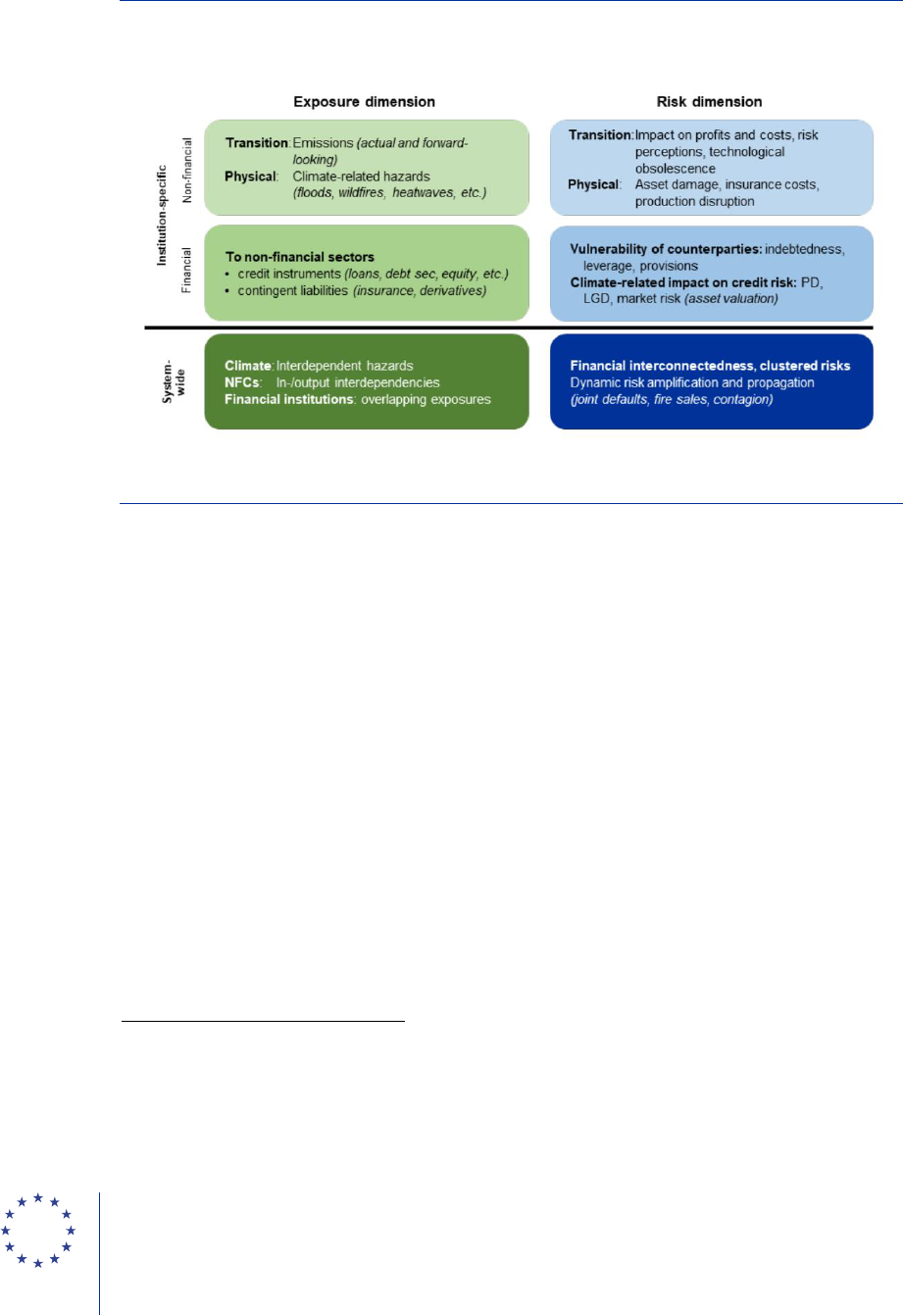
Climate-related risks and accounting April 2024
Introduction
6
of financial assets, and/or increase liabilities. Transition risks relate to the process of adjustment
towards a low-carbon economy. Physical and transition risks thus defined are placed in an
exposure-risk framework, which identifies system-wide vulnerabilities as well as institution-specific
vulnerabilities (European Central Bank and European Systemic Risk Board, 2022).
Figure 1
Climate-related exposure-risk framework
Source: European Central Bank and European Systemic Risk Board (2022).
This report does not elaborate on potential amendments to the prudential framework to
address the systemic impact of climate-related risks, and nor does it address the interaction
between the prudential framework and accounting. Rather, the scope of this report is limited to
a reflection on climate-related risks in IFRS accounting standards and the resulting financial
statements. Consequently, it does not discuss how the prudential framework could be used by
authorities to prevent or mitigate the financial stability impacts of the materialisation of climate-
related risks.
10
In the EU, there are ongoing discussions on how climate-related risks could lead to
amendments to the capital requirements for banks and insurance corporations (European Banking
Authority, 2023; European Insurance and Occupational Pensions Authority, 2023).
11
While
acknowledging the possible role of prudential regulation, this report does not perform any
comparative analysis on the benefits and costs of using prudential regulation to address climate-
related risks.
The IFRS Foundation, the European Commission and ESMA have been carrying out valuable
work in the realm of accounting and climate-related risks.
12
The International Accounting
Standards Board (IASB) of the IFRS Foundation, which issues IFRS accounting standards and
interpretations thereof, has issued two notes on how climate-related risks might interact with IFRS
10
Recommendations on adequate risk management within financial institutions could also contribute to alleviating the impact
of climate-related risks but are neither the goal of this report.
11
See also European Central Bank and European Systemic Risk Board (2023).
12
See also Martínez and Pérez Rodríguez (2023).

Climate-related risks and accounting April 2024
Introduction
7
accounting standards (Anderson, 2019; International Financial Reporting Standards Foundation,
2023). In March 2023 the IASB launched a project to explore whether and how companies can
provide better information about climate-related risks in their financial statements, and in
September 2023 it initiated targeted actions to improve the reporting of climate-related and other
uncertainties in the financial statements.
13
Moving to the European Union (EU), respondents to a
consultation on the Renewed Sustainable Finance Strategy in 2020 identified several areas in IFRS
accounting standards that could hamper the adequate and timely recognition and consistent
estimation of the impact of climate-related risks, particularly in relation to impairment, provisions
and contingent liabilities (European Commission, 2020). Following on from that consultation, the
European Commission is working with EFRAG (the European Financial Reporting Advisory Group),
ESMA, the IASB and the industry to ensure that financial reporting standards are able to capture
relevant sustainability and climate-related risks. Additionally, the EU Taxonomy Regulation was
adopted in 2020, with the aim of creating a dictionary of activities considered green and effective in
combating “greenwashing” practices. Recently, ESMA has flagged climate-related matters with
regard to financial information as an enforcement priority.
14
This report does not consider sustainability standards issued by the International
Sustainability Standards Board (ISSB) or the European Sustainability Reporting Standards
(ESRS). In November 2021, the IFRS Foundation decided to create the ISSB, to deliver a
comprehensive global framework for sustainability-related disclosures. The IFRS accounting
standards and the IFRS sustainability standards issued by the ISSB should complement each other
to provide investors and other capital market participants with comprehensive information to meet
their needs. In this sense, neither of those sets of standards should be considered in isolation.
ISSB standards relate to disclosures on material sustainability-related financial risks and
opportunities and are not directly drawn from the IFRS accounting framework. On 26 June 2023 the
ISSB issued finalised standards on general sustainability-related disclosure requirements and on
climate-related disclosure requirements.
15
In November 2022 EFRAG issued 12 Exposure Drafts of
ESRS covering environmental, social and governance topics.
16
The Commission adopted the first
set of ESRS as Delegated Acts in July 2023 and published them in December 2023.
17
Annex 2
describes the content of ESRS E1 Climate Change. Further standard-setting activities are ongoing
regarding a second set of ESRS, including sector-specific standards and other standards tailored to
listed small and medium-sized entities, scheduled for June 2024. The ESRS and the first two
standards issued by the ISSB at the global level were developed in parallel and in close
cooperation, resulting in a very high degree of alignment, as evidenced by overlapping sections of
ISSB standards having been integrated into the EU framework.
18
Such alignment does not call into
13
See IASB initiates project to consider climate-related risks in financial statements.
14
Annex 1 describes in further detail the work of ESMA in this area.
15
See ISSB issues inaugural global sustainability disclosure standards.
16
See Public consultation on the first set of Draft ESRS and First set of draft ESRS.
17
See Commission Delegated Regulation (EU) 2023/2772 of 31 July 2023 supplementing Directive 2013/34/EU of the
European Parliament and of the Council as regards sustainability reporting standards.
18
See European Commission, Questions and Answers on the Adoption of European Sustainability Reporting
Standards.

Climate-related risks and accounting April 2024
Introduction
8
question the consistency of ESRS with the EU’s own legal framework and the objectives of the
European Green Deal, which are broader in scope than the ISSB standards.
19
Connectivity between accounting and sustainability standards is important to ensure that
they both contribute to the provision of accurate information to the public. In sustainability
reporting, connectivity refers to the direct connection between sustainability information and
information in the financial statements or the general ledger (EFRAG, 2021).
20
The concept of
connectivity is linked to the provision to the public of a set of coherent and comprehensive
information in the annual report (Figure 2). The sustainability report, which is based on
sustainability standards, should complement and supplement the information contained in the
financial statements, which is based on accounting standards. In the EU context, ESRS 1 General
Requirements calls for reporting entities to connect their sustainability information with the
information they disclose in the financial statements.
21
More precisely, ESRS E1 Climate Change
requires a reconciliation of assets and net revenue linked to material physical risks to specific line
items in the financial statements.
22
This is one of the differences between IFRS S2 Climate-related
Disclosures (issued by the ISSB) and ESRS E1, as IFRS S2 does not have a similar requirement.
Connectivity should also prevent overlap of information in different parts of the annual report
(EFRAG, 2021).
23
A lack of connectivity between sustainability and accounting information can
diminish transparency, with potentially adverse impacts on the credibility of the information
disclosed, thus weakening market trust.
19
For more information on the European Green Deal, see The European Green Deal – Striving to be the first climate-
neutral continent.
20
While this could be defined as “direct” connectivity, it would also be possible to define “indirect” connectivity as referring to
sustainability disclosures that cannot be directly reconciled to the financial statements or accounting estimates in the
current period (EFRAG, 2023).
21
See Section 9.2 of ESRS 1 General Requirements.
22
See paragraph 68 and paragraphs AR77 to AR79 of ESRS E1 Climate Change.
23
Some degree of overlap may, however, be unavoidable, given that each set of standards has to stand on its own.
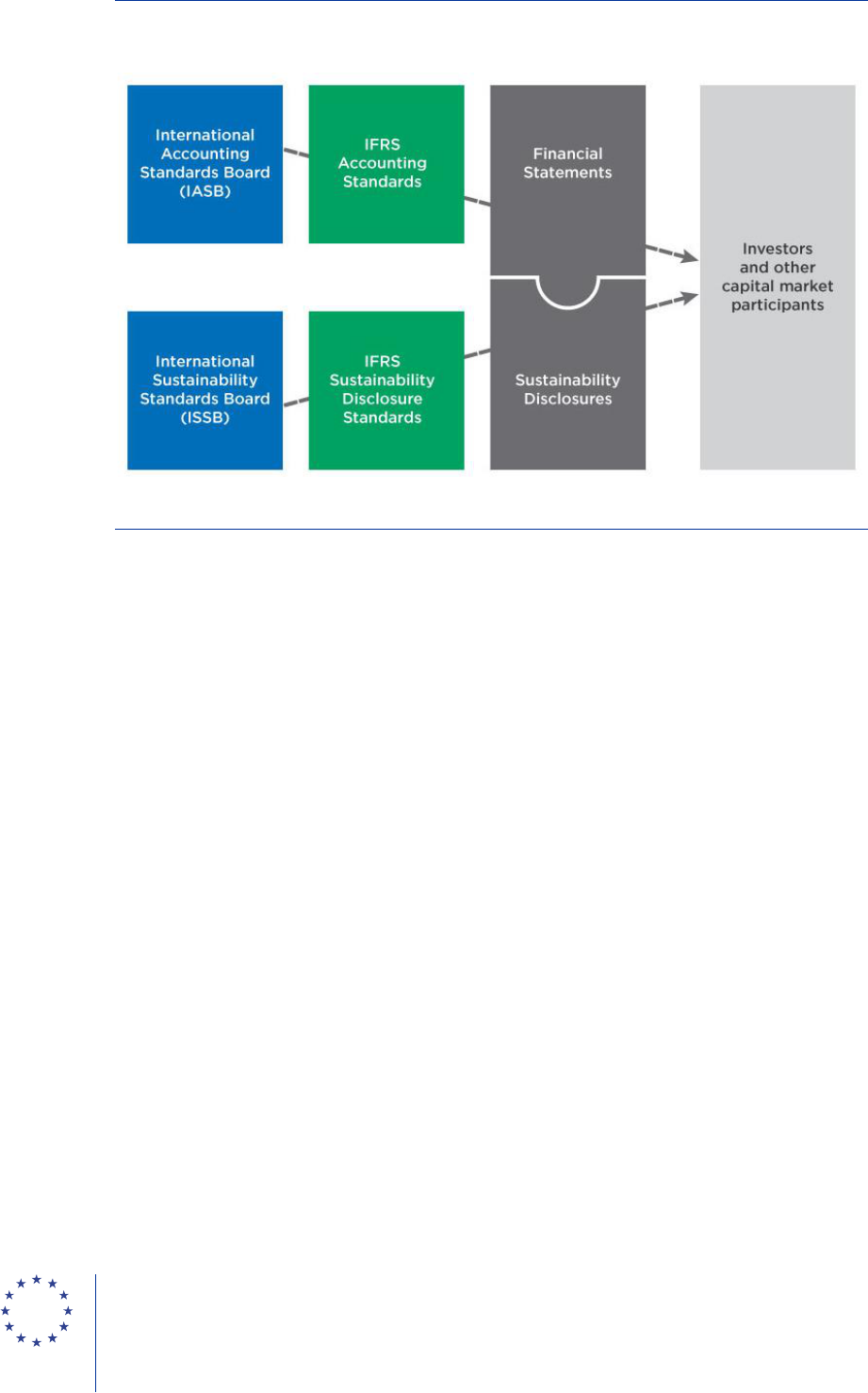
Climate-related risks and accounting April 2024
Introduction
9
Figure 2
International accounting and sustainability standards
Source: IFRS Foundation.
This report is organised as follows. Section 2 provides further methodological considerations on
how accounting can reflect climate-related risks and discusses channels through which the related
estimates could have an impact on financial stability. Section 3 presents the four main issues
identified for financial stability. Section 4 concludes by discussing potential policy actions to
address the issues identified.

Climate-related risks and accounting April 2024
Conceptual and methodological considerations
10
This section of the report outlines several important conceptual and methodological
considerations in the analysis of how accounting is able to reflect climate-related risks and
how this could affect financial stability. Subsection 2.1 below discusses the boundaries of
financial reporting, in relation to the events and transactions that lead to the recognition of an asset,
liability, income or expense (or a gain or loss). The section continues with a discussion of the
channels through which accounting can affect financial stability, focusing on climate-related risks.
2.1 The boundaries of financial reporting
At a conceptual level, climate-related risks can have accounting impacts and can also affect
the relevance, reliability and materiality of the information disclosed in the financial
statements. Accounting can be seen as a process starting with a set of definitions, recognition
criteria and measurement concepts, based on which accounting policy choices and judgements are
then made and applied in order to produce the estimates that ultimately result in the financial
statements. Climate-related risks can potentially affect accounting policy choices (e.g., when
accounting for emissions and pollutant pricing mechanisms), judgements (e.g., on impairment) or
estimations (e.g., of expected credit losses), as well as the criteria for the recognition and
measurement of assets and liabilities (e.g., adjustments to the useful life of assets, or liabilities
related to environmental damage). Decisions on the materiality of certain transactions can also be
affected by the expectations of users of financial statements or practices among peers, which may
render certain disclosures material, even if there are no quantified changes.
Only economic events and transactions that meet the definition of an asset, liability, income
or expense are reported in the financial statements. According to the conceptual framework for
financial reporting, the objective of financial statements is to provide financial information about the
reporting entity’s assets, liabilities, equity, income and expenses that is useful to users of financial
statements. An asset is defined as an economic resource controlled by the entity as a result of past
events, whereas a liability is a present obligation of the entity to transfer an economic resource as a
result of past events. Meanwhile, income and expenses are changes in assets and liabilities that
affect the net residual interest in the entity.
Therefore, the impacts of climate-related risks are included in the financial statements to the
extent that they meet the recognition criteria set out in IFRS accounting standards. Following
the definitions of physical and transition risks by the Financial Stability Board (2020a), physical risks
include, for instance, economic losses from natural catastrophes that have become more likely or
more severe due to the effects of climate change. Such losses can be reflected in the financial
statements to the extent that (i) they have already occurred and affect the existing rights and
obligations of an entity, or (ii) their increased severity or frequency affects the economic benefits
expected from the entity’s existing rights (for instance by reducing the useful life of property and
equipment) or future transfers arising from existing obligations (for example, natural catastrophes
2 Conceptual and methodological
considerations

Climate-related risks and accounting April 2024
Conceptual and methodological considerations
11
may increase the costs that the entity will incur to settle its obligations under an existing contract).
In contrast, recognition criteria preclude the financial statements from capturing the costs
necessary for an entity to mitigate and adapt its activities to climate-related hazards until the point
where it enters a legally binding commitment or has no practical ability to avoid its responsibility.
Similarly, financial statements do not provide information on how those hazards affect the margins
expected by the entity from new contracts entered into in the future. With regard to transition risks,
shifts in policies, technological changes and changes in customer behaviours may affect the
economic benefits that the entity expects to recover from its existing rights and should, therefore,
be reflected in the valuation of its assets in the statement of financial position. However, such
changes may also affect the entity’s ability to continue carrying on its activities in the future (i.e., as
a going concern). Furthermore, shifts in policies are “recognised” on the liability side of the financial
statements only once they are verified (e.g., when new legislation is enacted).
24
As a result, the
“going concern assumption” enshrined in the IASB Conceptual Framework for Financial Reporting
could come under scrutiny, potentially leading to a different measurement approach being applied
to certain items of the financial statements.
Consequently, fully capturing the long-term financial impacts of climate-related risks cannot
be achieved through accounting or sustainability reporting alone (Figure 3). Information
about an entity’s exposure to climate-related risks can only be partially addressed through
accounting. Even when designed and implemented optimally, accounting standards may not be
enough in themselves to obtain a comprehensive and accurate view of the exposure, given the
long-term and largely uncertain nature of climate-related risks. In particular, financial statements
may not adequately reflect (i) risks that materialise beyond the time horizon over which the entity
expects economic benefits from its assets and cash outflows to settle its liabilities, and (ii) the future
actions that an entity may be compelled to take in order to mitigate and adapt to climate-related
risks and continue to operate as a going concern. In other words, when accounting pays too much
attention to future events, it can become less reliable and less robust; in turn, when it disregards
future events entirely, it may not adequately represent the reporting entity’s financial position. To a
certain extent, this limitation explains why the EU and the IFRS Foundation have adopted
sustainability reporting standards, which are designed to complement financial reporting by
providing information about how sustainability matters (including climate change) affect the entity’s
activities, performance, risks and long-term value. Connectivity between both sets of information is
key to the optimal disclosure of climate-related risks.
24
Similarly, for liabilities associated with climate-related litigation arising from legislation, in many cases sufficient evidence
would not arise until the new legislation is enacted (or is close to being enacted).
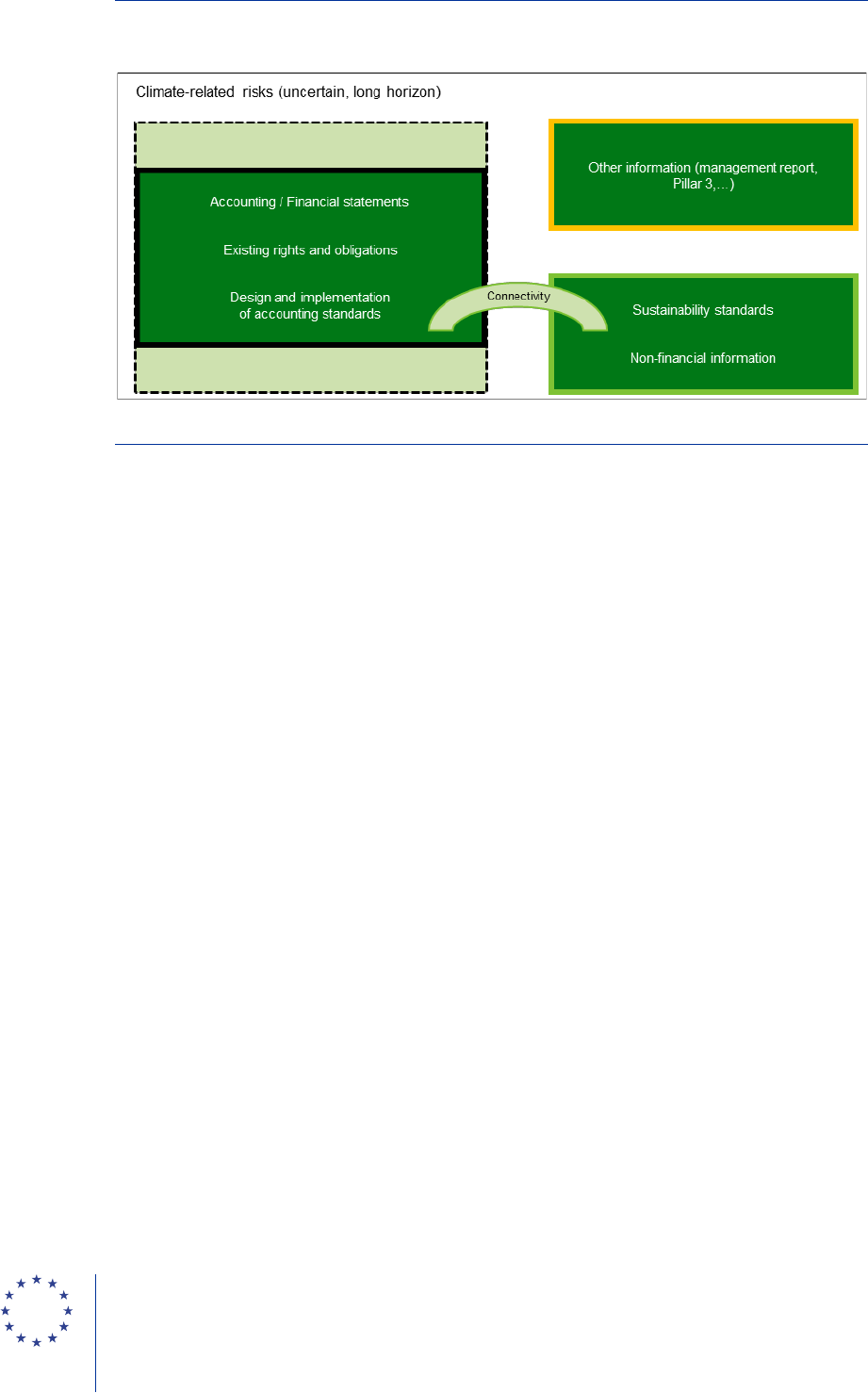
Climate-related risks and accounting April 2024
Conceptual and methodological considerations
12
Figure 3
Climate-related risks, accounting and sustainability reporting
Source: Own illustration.
Lastly, uncertainty about the future impact and timing of the materialisation of climate-
related risks is an important factor to consider when assessing how accounting may reflect
such risks. At this point, it is important to draw a distinction between “risk” and “uncertainty”: risks
are in principle measurable (as the probabilities and possible outcomes are objectively or
subjectively determinable) and, as long as they have a monetary or financial effect on the reporting
entity, should be reflected in the financial statements, while uncertainty can at best be estimated as
no probability can be reliably associated to any possible outcome. The prevailing uncertainty
surrounding the timing and extent of the materialisation of climate-related risks can affect the
assessment of an entity’s ability to continue as a going concern. Furthermore, bringing climate-
related risks into the financial statements may add complexity to several estimations, ranging from
impairment testing to expected cash flows, risk adjustments to the discount rates or expected credit
losses. Although IFRS accounting standards require forward-looking estimates of variables that
affect the assets and liabilities reported in the financial statements at the end of the reporting
period, these estimates should be disclosed over a short-term horizon only: the next financial year.
In fact, IAS 1.125 requires that the entity’s assumptions about the future and other major sources of
estimation uncertainty be disclosed only if the referred variables “have a significant risk of resulting
in a material adjustment to the carrying amounts of assets and liabilities within the next financial
year”. Consequently, the financial impact of climate-related risks over the longer term may not be
captured in a company’s financial statements.
2.2 Climate-related risks, accounting and financial stability
Accounting can be seen as a process of conveying the impact of economic events and
transactions to users of financial statements. Based on conceptual foundations around the
notions of assets, liabilities, equity, income and expense, accounting standards define the
principles building on which economic phenomena are presented to users of financial statements in

Climate-related risks and accounting April 2024
Conceptual and methodological considerations
13
order to inform their decision-making in a relevant and reliable way.
25
Inspired by those principles,
management of reporting entities defines the accounting policies and measurement assumptions
relied on in determining the estimates set out in the financial statements. The information contained
in the financial statements should then provide decision usefulness, in the sense that it can be used
by the public to make qualified and educated opinions on the reporting entity.
Although the accounting process is not primarily meant as a tool to foster financial stability,
there are at least three channels through which relevant and reliable financial information
resulting from this process can be beneficial to financial stability: through transparency
(channel 1 in Figure 4); through the behavioural response of economic agents to accounting
information (channel 2 in Figure 4); and through regulation (channel 3 in Figure 4). First,
transparency in accounting, understood as access to relevant, reliable, comprehensive and timely
financial information about an economic agent, enables users of financial statements to make
informed decisions of an economic nature. It promotes market discipline, which discourages
reporting entities from engaging in risky behaviours and transactions and supports efficient
allocation of resources. Transparency would thus be linked to the concept of “true and fair view”,
according to which the financial statements should not contain falsehoods (i.e., be true) and should
accurately report the condition they wish to portray (i.e., be fair). Second, even if theoretically
accounting standards should be neutral for economic decision-making, in practice they may also
incentivise certain behaviours among economic agents, which may, in turn, give rise to financial
stability concerns. Lastly, accounting is either the starting point or key reference when defining
prudential requirements for regulated financial institutions, thus affecting their solvency and liquidity
picture.
If markets function properly and information on risks is adequately incorporated into the
financial statements, the pricing of different assets should adjust accordingly and no
financial stability concerns should arise. This illustrates the crucial importance of properly
accounting for risks in the financial statements. In the absence of such proper accounting, either
one or all of those three transmission channels could be activated by a sudden reassessment of
investor expectations that forces abrupt adjustments in the financial statements (i.e., an
“information shock”). Those shocks could potentially affect financial stability through a combination
of fire sales, higher cost of capital and suboptimal allocation of resources.
26
25
In other words, accounting comprises the processes whereby business activities and commercial transactions are
accounted for, together with the economic impacts relevant for their respective measurement.
26
As explained by Pérez Rodríguez (2021), information shocks tend to follow episodes of unanticipated corporate failure
associated with irrational balance sheet expansions, and their negative externalities are usually felt in the form of higher
costs of capital being imposed on reliable and unreliable companies alike.
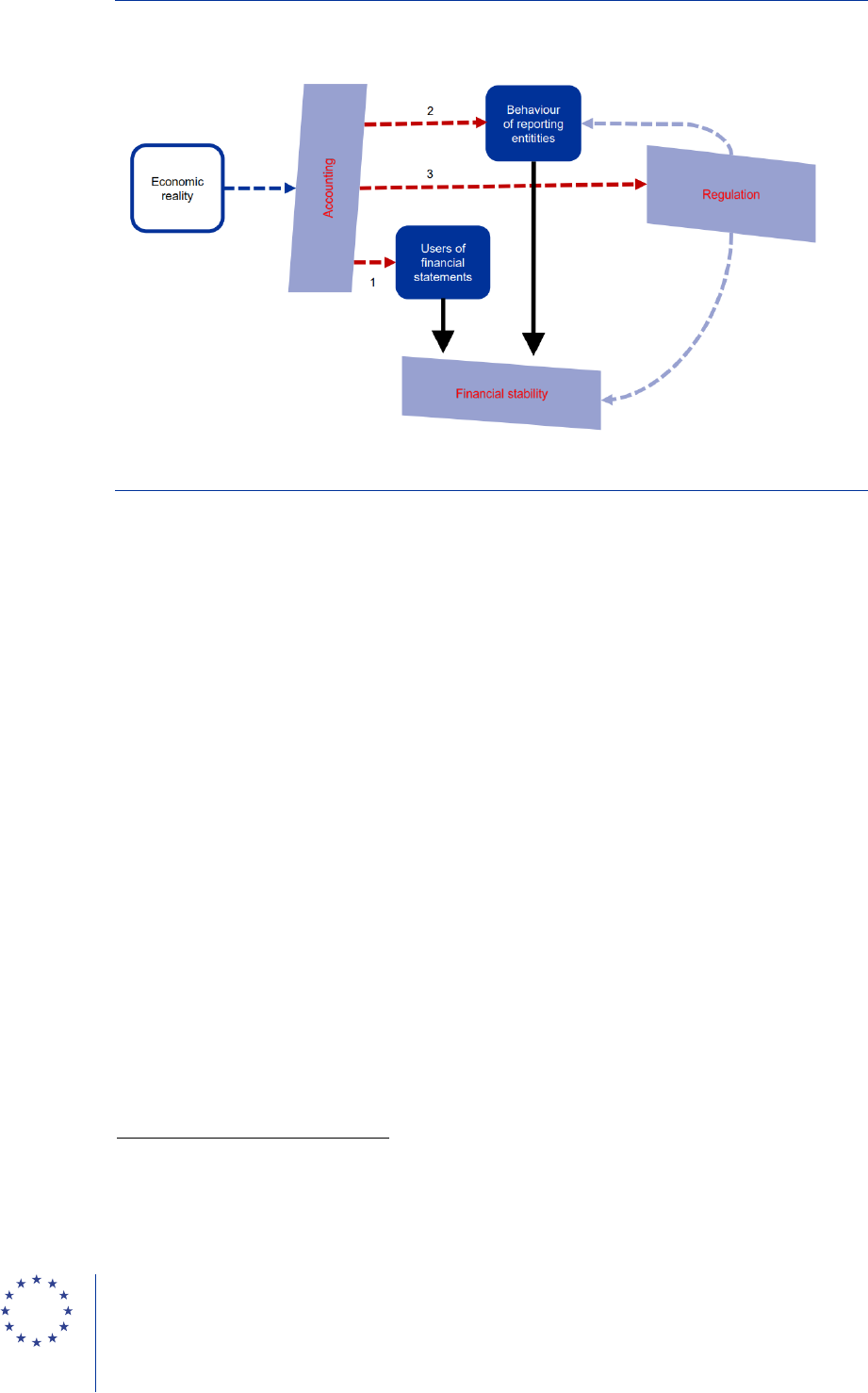
Climate-related risks and accounting April 2024
Conceptual and methodological considerations
14
Figure 4
Accounting and financial stability
Source: European Systemic Risk Board (2021).
In the case of climate-related risks, “information shocks” and, more broadly, a lack of
relevant and reliable financial information, could affect financial stability through the three
transmission channels described above. In terms of transparency, accounting information that
misstates the value of assets or liabilities, does not appropriately reflect the accrual of income or
expenses, or fails to recognise gains or losses in timely fashion can lead users of the financial
information to make suboptimal economic decisions. This would be the case where climate-related
risks are not incorporated into the valuation of assets or liabilities, but also if poor disclosures are
provided regarding the assumptions on how the reporting entity might be affected by those risks. In
any of those cases, overestimation of assets, anticipation of income or gains, underestimation of
liabilities, or deferral of expenses or losses could result in large adjustments if and when the risks
materialise, especially where such risks are highly uncertain and/or have long horizons. Regarding
the behaviour of reporting entities in response to how accounting reflects climate-related risks,
certain types of responses would be detrimental to financial stability, such as delays in recognising
certain liabilities or expenses arising from environmental considerations, concentration of
exposures to certain asset types that receive a more favourable accounting treatment in
comparable terms,
27
or underestimation of the impact of climate-related risks on the balance sheet
and statement of profit or loss. A generalised, inaccurate reflection of climate-related risks in the
financial statements of reporting entities could lead economic agents to base their economic
decisions on suboptimal information. Lastly, the inclusion in regulatory calculations of accounting
information not appropriately reflecting climate-related risks could hamper the assessment by
regulatory and supervisory authorities of the solvency and liquidity of the reporting entity. For
instance, not incorporating climate-related risks into the expected credit loss model under IFRS 9,
27
For example, this could occur in the case of certain assets measured at cost, for which the impairment test does not
sufficiently take into account climate-related risks, while assets at fair value would already incorporate climate-related risks
in their market values.

Climate-related risks and accounting April 2024
Conceptual and methodological considerations
15
or into the IRB model parameters, could affect the determination of capital requirements for banks.
In all those cases, financial stability could be affected by an information shock and the ensuing
adjustments could trigger widespread divestment in certain sectors and activities, a rebalancing of
positions, and potentially significant movements in holdings of financial assets among market
participants.
While financial institutions may not be largely exposed to physical or transition risks
directly, their interactions with the real economy indirectly expose them to climate-related
risks, the materialisation of which can have financial stability implications. Looking at the
definitions of physical and transition risks used in this report, the financial stability implications of
direct exposures to these risks among financial institutions should be rather limited. However,
through their exposures to the real economy in the form of loans, real estate collateral, insurance
contracts or holdings of securities, they may be indirectly affected by climate-related risks. The way
in which these risks are reflected in the financial statements may raise financial stability concerns.
For example, climate-related risks could affect the value of real estate and similar immovable
assets, and significantly affect banks and other financial institutions through large direct or indirect
exposures (e.g., via real estate funds or securitisations). Similarly, a sudden and substantial
deterioration in the quality of bank loan books, as a result of climate-related risks not adequately
reflected in their value, could lead to deleveraging and a procyclical retrenchment in credit activity.
This could also trigger credit rating downgrades, higher credit spreads and, more broadly, a loss of
trust across financial institutions and their customers, with further contagion and spillover effects.
28
Similarly, failure to timely incorporate climate-related risks in the fair value of financial instruments
could trigger large sudden decreases in their fair value, which, if held by banks or insurance
corporations could trigger fire sales of assets and affect the availability of credit and insurance
services.
29
The emergence of large unrecognised losses from climate-related factors not
considered when estimating the technical provisions of existing insurance contracts (such as home
insurance policies) is another example of the type of information shock that could affect financial
stability if accounting standards are not properly implemented, thus leading to suboptimal financial
statements.
The interactions between the financial system and non-financial corporations in considering
and recognising the impact of climate-related risks, needs to be expanded, to take into
account the environmental reality and the related sustainability standards (Figure 5). As
shown in Figure 5, the environmental reality interacts with the economic reality and is the object of
sustainability reporting standards. At this stage, connectivity between accounting and sustainability
reporting standards is of paramount importance, as users of financial information and sustainability
reports may otherwise receive contradicting information on the same reality. For example, when
sustainability reporting explains the physical or transition risks arising from an entity’s activities and
its assets and liabilities, such disclosures could be linked to the corresponding provisions that
would be required in the financial statements. Sustainability disclosures may also provide early
indications of matters that could subsequently be reflected in the financial statements (for instance,
a commitment to net zero emissions could, over time, result in liabilities being reported in the
financial statements). Accounting and sustainability information should, in conjunction, provide a
28
This would be the case for loan portfolios used as collateral for collateralised loan obligations (CLOs).
29
In the case of securitisations, collateralised debt Obligations (CDOs) could also be materially affected.
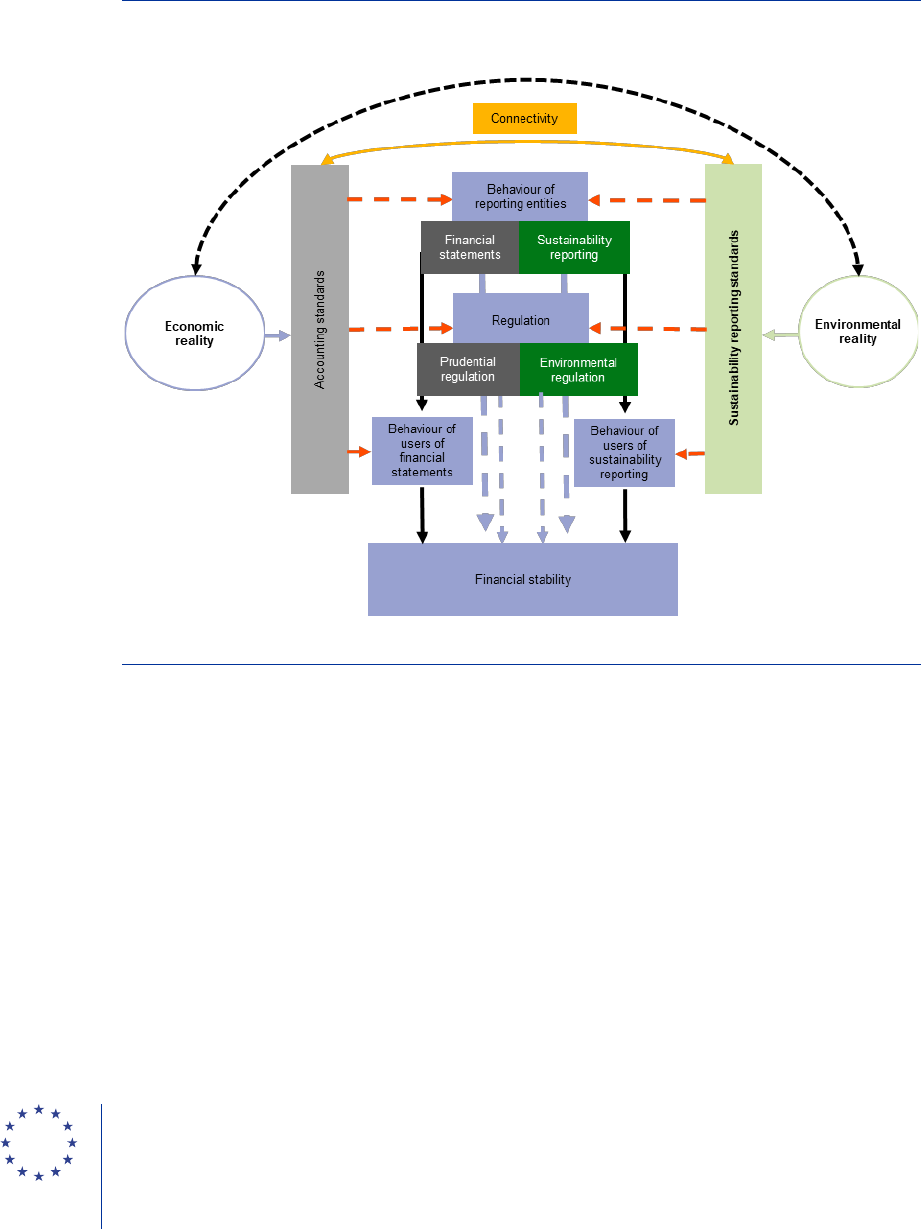
Climate-related risks and accounting April 2024
Conceptual and methodological considerations
16
holistic, comprehensive and coherent picture of the climate-related risks faced by the reporting
entity and their expected impact. Conversely, the use of disconnected information for prudential
and environmental regulatory purposes could lead to inconsistencies. Reporting entities could also
decide to favour disclosures in either the financial statements or in sustainability reporting, to suit
their own objectives. A lack of connectivity between these two reflections of similar realities would
certainly lead to a suboptimal provision of information to the public, potentially hampering the
proper functioning of financial markets when it comes to risk pricing and the allocation of financing
activities and capital flows from investing.
Figure 5
Accounting, sustainability reporting and financial stability
Source: Own illustration.

Climate-related risks and accounting April 2024
Main issues identified
17
A subset of IFRS accounting standards have been identified as being more closely related
to climate-related risks. Based on other assessments (Anderson, 2019; European Commission,
2020; International Financial Reporting Standards, 2020) and on expert judgement, the following
IFRS accounting standards have been identified: IAS 1 Presentation of Financial Statements, IAS 2
Inventories, IAS 8 Accounting Policies, Changes in Accounting Estimates and Errors, IAS 16
Property, Plant and Equipment, IAS 36 Impairment of Assets, IAS 37 Provisions, Contingent
Liabilities and Contingent Assets, IAS 38 Intangible Assets, IAS 40 Investment Property, IAS 41
Agriculture, IFRS 6 Exploration for and Evaluation of Mineral Resources, IFRS 7 Financial
Instruments: Disclosures, IFRS 9 Financial Instruments, IFRS 13 Fair Value Measurement, and
IFRS 17 Insurance Contracts.
From an in-depth analysis of these IFRS accounting standards, the ESRB has identified four
main issues of relevance for financial stability. They refer to (i) the extent to which market
prices – and hence fair values of Level 1 and Level 2 financial assets or the discount rates used to
compute present values – incorporate climate-related risks, both physical and transition; (ii) the
effect of such risks on the initial and subsequent valuation of non-financial assets and liabilities,
including property, plant and equipment, intangibles, goodwill, provisions and contingent liabilities;
(iii) the incorporation of climate factors into the models used by preparers of financial statements,
including factors affecting expected cash flows, risk adjustments to the discount rates for insurance
liabilities or the estimation of expected credit losses from financial assets at amortised cost (e.g.
loans); and (iv) disclosures. The following subsections explore these issues in further detail, while
Table A1 in Annex 3 lists the IFRS accounting standards most closely linked to them.
30
The order in
which the four issues are presented does not imply any prioritisation or ranking.
3.1 The extent to which market prices incorporate climate-
related risks
The incomplete incorporation of climate-related risks in market prices can cause assets to
be overestimated or liabilities to be underestimated.
31
Several IFRS accounting standards rely
on market prices for the purpose of valuing assets and liabilities. Examples here include financial
assets at fair value and, optionally, tangible assets and investment property or the discount rates
applied when measuring insurance liabilities.
32
It also holds true for the initial measurement of
acquired assets, as cost is equivalent to fair value at the time of acquisition. If these assets and
liabilities are directly or indirectly affected by climate-related risks but their market prices (or,
30
Neither the four issues identified nor the related IFRS accounting standards are exhaustive.
31
Market prices simply reflect prices of actual (or potential) transactions and may be under- or overestimating some risks.
Ideally, all relevant risks, including climate-related risks, should be incorporated into the market price of an asset. This is
the approach taken in the following paragraphs, which should not be seen as calling for a correction of market prices to
incorporate climate-related risks.
32
When measuring insurance liabilities, IFRS 17 requires the discount rates to be market consistent and to reflect the
characteristics of the liability. That would imply eliminating any “climate-related risk premium” implicit in the fair value of the
reference portfolio of assets when determining the discount rate. For further details on the computation of discount rates
under IFRS 17, see European Systemic Risk Board (2021).
3 Main issues identified

Climate-related risks and accounting April 2024
Main issues identified
18
alternatively, the discount rates) do not fully reflect such risks, financial statements could potentially
lead to suboptimal economic decisions.
33
Furthermore, failing to incorporate climate-related risks in
market prices could also hamper the accuracy of computed liquidity premia.
Not incorporating climate-related risks in the market prices of financial instruments would
affect their fair values, as well as provisions or tangible assets measured at fair value and
exposed to climate-related risk factors.
34
Banks, insurance corporations, pension funds and
investment funds can be affected through their holdings of equity instruments (including investment
fund shares) and debt securities. While not in the aggregate, certain non-financial corporations may
also be affected to the extent that they hold financial assets on their balance sheet. As shown in
Chart 1, which reflects data from the Quarterly Sector Accounts, holdings of debt securities and
equity instruments in the euro area amount to more than €25 trillion, representing around 50% of
total assets in some institutional sectors. On top of that, non-financial corporations that opt for the
revaluation model for their property, plant and equipment or measure investment property at fair
value would also be affected,
35
although there is sparse evidence of the extent to which such a
measurement basis is actually applied among EU non-financial corporations. Christensen and
Nikolaev (2013) find that only 3% of the 1,539 non-financial corporations included in their sample
and domiciled in the United Kingdom and Germany use fair value for non-current assets after their
first-time adoption of IFRS. Investment property represents a small share of the aggregated
balance sheet of EU non-financial corporations (2.4% at the end of 2021, according to the ERICA
database of the European Committee of Central Balance Sheet Data Offices) and is often
measured at fair value, particularly by real estate non-financial corporations (Olante and Lassini,
2022).
36
33
For example, certain climate-related factors (such as high locked-in greenhouse gas emissions) may not be reflected in the
market price as of the acquisition date, thus affecting the asset’s initial measurement. Moreover, given the long-term
horizon over which climate-related risks materialise, it may be the case that the market price of certain short-term financial
instruments is not affected by those risks.
34
IFRS require the fair value of certain non-financial assets measured at amortised cost, such as investment property, to be
disclosed in the notes to the financial statements.
35
Assets measured at amortised cost could potentially be affected as well, in case their market value revealed a substantial
decline in their recoverable amount, which would lead to the recognition of significant impairment losses.
36
For further information on the ERICA database, see ECCBSO – Erica Working Group.
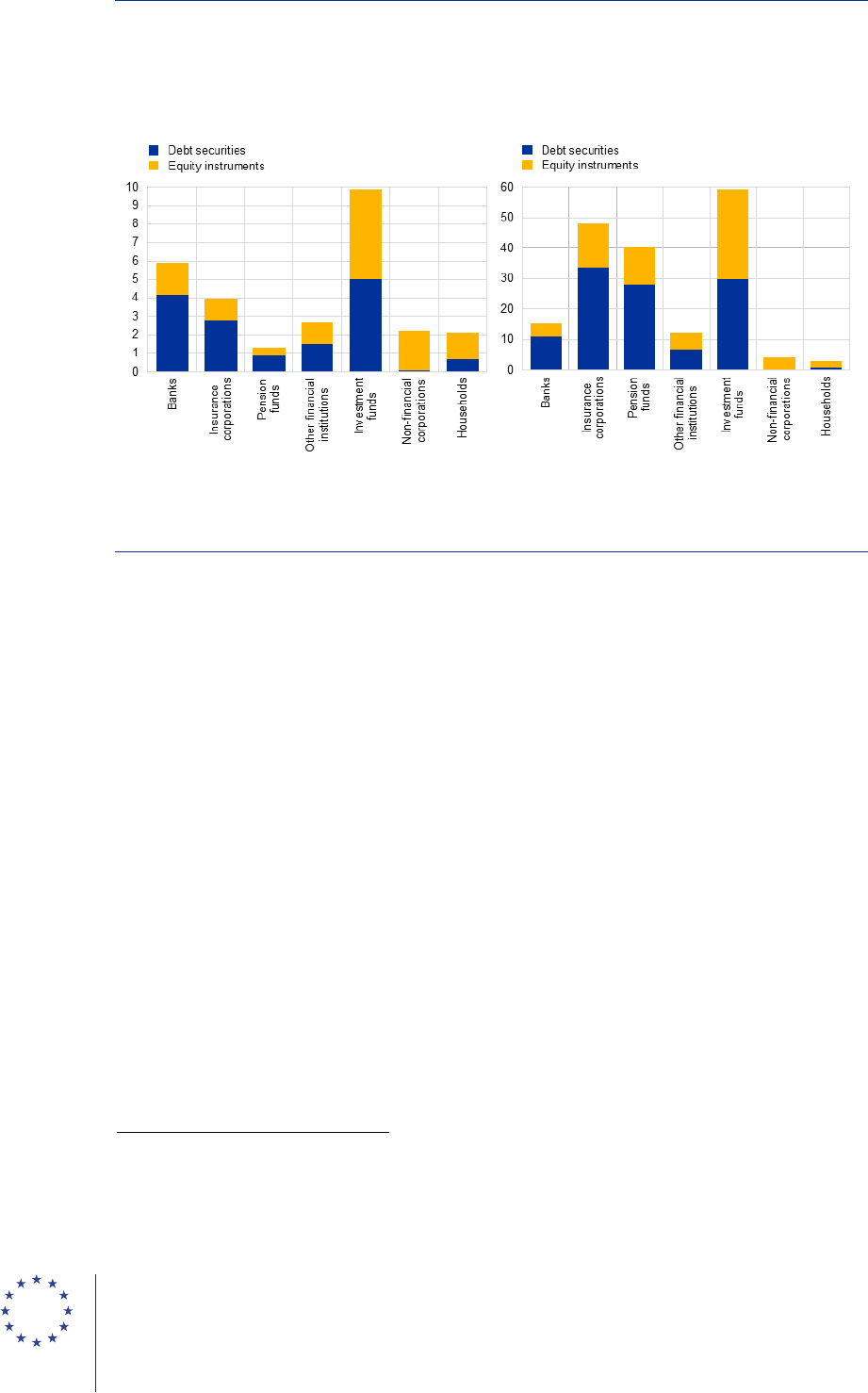
Climate-related risks and accounting April 2024
Main issues identified
19
Chart 1
Debt securities and equity instruments held by euro area institutional sectors, Q2 2023
a) Total volume
b) Share of total assets of each sector
(EUR trillions)
(percentages)
Sources: ECB and ESRB Secretariat calculations.
Notes: Information based on the System of National Accounts. The sectors of rest of the world, money market funds,
government and central banks are excluded.
Regardless of the above considerations, the inclusion of climate-related risks in the market
price of certain assets is a matter that goes beyond the accounting realm. Given that fair
value is understood as an exit price, i.e., the price at which an asset would be transferred (or a
liability assumed) between knowledgeable parties not forced to transact, accounting standards
typically take market prices as a proxy for fair value. In that sense, the fair value of an asset is
based on assumptions and methodologies developed by market participants and therefore reflects
a “consensus” within a market at a point in time. For financial assets in Level 1 and, to a certain
extent, in Level 2, fair value can be considered an objective measure, free from management
influence.
37
The underlying assumption is that market prices incorporate the significant risks to
which the asset is exposed, though these prices may not fully incorporate all externalities related to
the underlying asset. In these situations, accounting standards do not usually provide an alternative
measurement criterion that can replace or adjust the asset’s fair value or, in the case of traded
financial instruments, such alternative measurement criterion may not be preferable. There have
been recent discussions on the extent to which climate-related risks are incorporated into the
market prices of a wide variety of assets (European Systemic Risk Board, 2020b; Basel Committee
on Banking Supervision, 2021).
38
Even if this is a matter that goes beyond the accounting realm,
accounting standard-setters have not questioned the reliance on fair value (subject to the
necessary adjustments) to measure assets and liabilities in those cases. Eren et al. (2022) provide
a summary of the findings in the academic literature on the same topic, revealing an incomplete
and imperfect view of how market prices reflect climate-related risks. Stroebel and Wurgler (2021)
37
For further information on the fair value hierarchy, see European Systemic Risk Board (2020a).
38
See HSBC's Stuart Kirk tells FT investors need not worry about climate risk for a controversial contribution to the
discussion.

Climate-related risks and accounting April 2024
Main issues identified
20
conducted a survey among 861 finance academics, professionals, public sector regulators and
policy economists, with most respondents believing that asset prices underestimate climate-related
risks.
Although the expectation would be for market prices to gradually incorporate climate-
related factors, a scenario of sudden adjustment cannot be completely ruled out. While the
transition to a low-carbon economy is likely to unfold over time and the current uncertainty around
the physical impacts of climate change should gradually dissipate, we cannot rule out scenarios
involving a sudden and disorderly transition or, as a result of non-linearities, a sudden and abrupt
materialisation of the physical impacts of climate-related risks. Such scenarios could lead to large
and abrupt shifts in market expectations, driving substantial changes in market prices, large
revaluations or adjustments to the carrying amounts, and the accompanying losses. Either because
of correlated exposures and herd behaviour, or as a result of counterparty risk and contagion given
the significant interconnections existing within the financial system, this may simultaneously affect a
large group of financial institutions, with the resulting adverse consequences for financial stability.
39
However, the information available to financial market participants on the exposure to climate-
related risks is expected to improve with the adoption of ESRS and ISSB standards, likely reducing
the probability of a sudden incorporation of climate-related risks into the price of financial
instruments. Meanwhile, the adoption of the ESAP (European Single Access Point) Regulation may
also make it easier for market participants to collect and process information electronically, which
could help in better pricing climate-related risks.
40
3.2 The valuation of non-financial assets and liabilities
Failing to fully include relevant climate-related risks in impairment tests for non-financial
assets may affect their valuation. The valuation of certain categories of fixed assets (such as
those accounted for under IAS 16 Property, Plant and Equipment, IAS 40 Investment Property, IAS
41 Agriculture or IFRS 6 Exploration for and Evaluation of Mineral Resources) may be affected by
climate-related risks (specific examples include machinery that fails to comply with certain pollution
regulations, goodwill that fails to take on board the impact of physical or transition risks on the
expected cash flows of the acquired business, land used for agricultural activities affected by
heatwaves, or buildings with a low energy performance). These assets are typically accounted for
at cost in the balance sheet of non-financial corporations, and are therefore subject to impairment
under IAS 36 Impairment of Assets.
41
According to IAS 36, entities must compare the carrying
amount of assets with their recoverable amount (defined as the higher of fair value less costs of
disposal and value in use) and recognise an impairment loss if the recoverable amount is below the
carrying amount. With the exception of goodwill and certain intangible assets for which an annual
impairment test is required, entities are required to conduct impairment tests whenever there is an
indication of asset impairment.
39
Furthermore, recent developments in energy derivatives markets show how non-financial corporations are increasingly
participating in these markets.
40
See Easy access to corporate information for investors: Provisional agreement reached on the European Single
Access Point (ESAP).
41
Fair value less costs of sale is the preferred valuation method under IAS 41, although cost less accumulated depreciation
and impairment must be used when fair value measurements are unreliable.

Climate-related risks and accounting April 2024
Main issues identified
21
Where relevant, non-financial corporations should incorporate climate-related factors into
the impairment tests, even if these factors are not explicitly mentioned in IAS 36. In
particular, value in use is a forward-looking estimate that reflects an entity’s expectations about
future cash flows over the lifetime of the assets, and therefore relies fully on management
expectations. While there is no explicit guidance to incorporate climate-related risks in the
estimation of an asset’s value in use, the time horizon for developing explicit assumptions about
future cash flows is usually limited to five years (see IAS 36.33.b), and beyond this time horizon
entities should use a long-term growth rate to infer expected cash flows over the lifetime of the
assets. Consequently, the incorporation of climate-related risks in the value in use of an asset
subject to impairment depends on the accounting policies, judgements and assumptions made by
each entity, which can lead to inconsistent measurement and impaired comparability in the cross
section.
A scenario of sudden realisation of risks could critically affect the corporate sector, as well
as the banking sector through lending exposures. It would be reasonable to expect a gradual
adjustment over the years of the carrying amount of non-financial assets subject to significant
climate-related risks, through appropriate and timely impairment charges. However, it is also
possible that the process may not run smoothly system-wide, with asset values not being adjusted
over time, thus leading to a sudden drop in value.
42
If the related losses came to affect the financial
position of a broad enough group of non-financial corporations representing a large share of banks’
loan portfolios, there could be a surge in credit losses and a rapid deterioration in the banking
sector’s solvency.
Looking at the aggregate balance sheet of the euro area banking system, loans to sectors
highly contributing to climate change represent around 80% of all loans to non-financial
corporations (diamonds in Chart 2). Recital 6 of Commission Delegated Regulation 2020/1818
identifies the sectors that highly contribute to climate change, as those represented by NACE codes
A to H, and L.
43
On average, they account for around 80% of the loan exposures of EU banks to
non-financial corporations. A similar classification of economic activities most affected by climate
transition risks is provided by FINEXUS: Center for Financial Networks and Sustainability, revealing
similar results.
44
,
45
From this point of view, the late and massive recognition of climate-related
changes in the asset values of non-financial corporations could have a significant impact on the
balance sheets of banks (see also Battiston et al., 2017).
46
42
At the extreme, this could lead to the valuation of the related assets and of the non-financial corporations on a gone-
concern basis.
43
See Commission Delegated Regulation (EU) 2020/1818 of 17 July 2020 supplementing Regulation (EU) 2016/1011
of the European Parliament and of the Council as regards minimum standards for EU Climate Transition
Benchmarks and EU Paris-aligned Benchmarks.
44
See Climate Policy Relevant Sectors.
45
These results depend crucially on the estimation of how climate-related risks affect each sector of activity. Different
estimations can lead, logically, to different results, particularly at national level where more granular information may be
available.
46
For further reading, see European Central Bank and European Systemic Risk Board (2023).
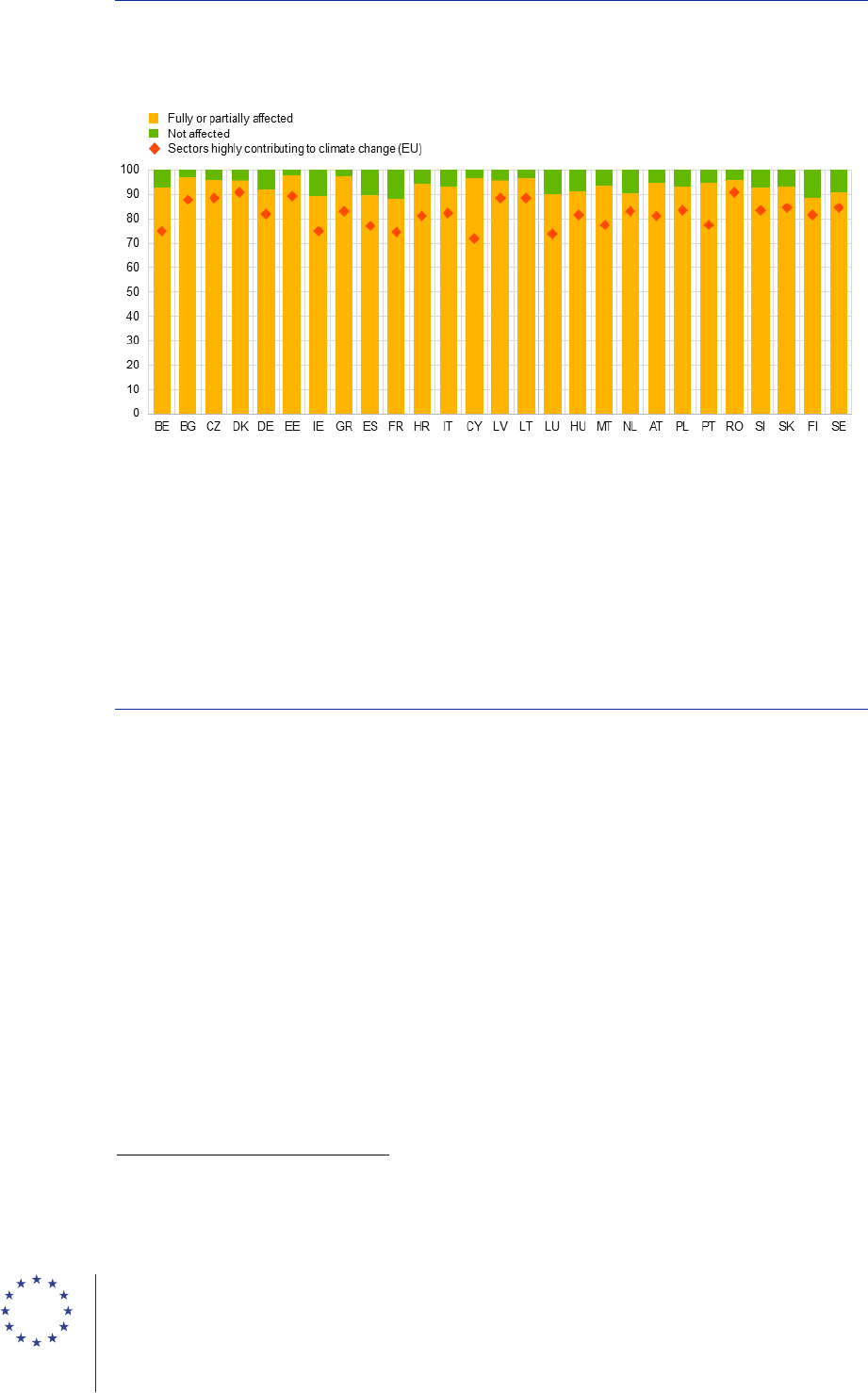
Climate-related risks and accounting April 2024
Main issues identified
22
Chart 2
Loan exposures of EU banks to climate-sensitive sectors, 2022
(percentages)
Sources: ECB and ESRB Secretariat calculations.
Notes: The bars represent the share of loans to non-financial corporations affected by climate transition risks, according to the
classification by FINEXUS into sectors fully affected by climate-related risks (A – Agriculture, Forestry and Fishing, D –
Electricity, Gas, Steam and Air Conditioning Supply, H – Transportation and Storage, and L – Real Estate Activities), sectors
partially affected (B – Mining and Quarrying, C – Manufacturing, F – Construction, G – Wholesale and Retail Trade; Repair of
Motor Vehicles and Motorcycles, I – Accommodation and Food Service Activities, M – Professional, Scientific and Technical
Activities, and N – Administrative and Support Service Activities) and sectors not affected (E – Water Supply; Sewerage, Waste
Management and Remediation Activities, J – Information and Communication, K – Financial and Insurance Activities, R – Arts,
Entertainment and Recreation, and S – Other Service Activities). Sectors O – Public Administration and Defence; Compulsory
Social Security, P – Education, and Q – Human Health and Social Work Activities are considered not affected. The diamonds
represent the share of loans to non-financial corporations in the sectors highly contributing to climate change, as identified in
Commission Delegated Regulation 2020/1818. Information retrieved from the ECB’s consolidated banking data dataset for
domestic and standalone banks as well as for foreign subsidiaries and branches reporting under FINREP.
More specifically, failure to adequately consider climate-related risks in the valuation of real
estate can be a direct source of concern for banks and other financial institutions.
47
According to the EBA Risk Dashboard, EU banks had exposures towards the real estate and
construction sectors of €1.487 trillion in the second quarter of 2023, representing around 30% of
loans to non-financial corporations. Meanwhile, mortgages to households represent more than 20%
of total loans granted by banks and real estate is used as collateral in around 6% of the total loans,
thus increasing the exposure of EU banks to the real estate sector (Chart 3). The valuation of real
estate can be affected by climate-related considerations, such as the asset being located in an area
prone to flooding, a building’s energy consumption pattern or features rendering the asset
uninsurable. If not promptly addressed, these considerations could generate large losses for the
47
Although real estate is currently perceived as being particularly affected by climate-related risks, this does not prevent key
assets in other areas of activity (such as shipping or aviation) from being similarly perceived in the future.

Climate-related risks and accounting April 2024
Main issues identified
23
banking system.
48
Besides construction, real estate and mortgages, a second channel of exposure
among financial institutions relates to their direct holdings, investments or participations in
companies that hold non-financial assets potentially exposed to climate-related risks, such as
commercial real estate.
49
Chart 3
Loans related to real estate as a share of total loans of EEA banks
(percentages, EUR billions)
Sources: EBA Risk Dashboard and ESRB Secretariat calculations.
Note: Amounts refer to the second quarter of 2023, as reported to the EBA Risk Dashboard for the sample of EEA banks.
Similarly, non-financial corporations operating in certain sectors of activity may not
adequately report climate-related liabilities due, among other factors, to the prevailing
uncertainty about the future impact of climate-related risks. According to IAS 37 Provisions,
Contingent Liabilities and Contingent Assets, entities must recognise a provision for liabilities of
uncertain timing or amount only if an event has already occurred. Provisions must be measured at
the best estimate (including risks and uncertainties) of expenditures required to settle the present
obligation, reflecting the present value of such expenditures where the time value of money is
material. Non-financial corporations may incur sizeable liabilities as a result of compensation
sought by third parties for losses inflicted by the entity’s past polluting activity, new regulation
requiring rehabilitation of environmental damage,
50
or the liability risk resulting from non-compliance
with environmental regulation (through potential stakeholder litigation or supervisory enforcement
action). In turn, some contracts may become onerous as a result of transition risks (notably, in the
oil and gas industry), in which case the non-financial corporation is required to recognise the loss it
expects on those contracts only where an adverse climate-related event has already occurred.
48
In this regard, the modified Article 229 of the Capital Requirements Regulation (CRR) states that “The value of the property
can exceed that average value or the value at origination, as applicable, in case of modifications made to the property that
unequivocally increase its value, such as improvements of the energy performance or improvements to the resilience,
protection and adaptation to physical risks of the building or housing unit.” (see Proposal for a Regulation of the
European Parliament and of the Council amending Regulation (EU) No 575/2013 as regards requirements for credit
risk, credit valuation adjustment risk, operational risk, market risk and the output floor - Confirmation of the final
compromise text with a view to agreement).
49
See European Systemic Risk Board (2023).
50
According to IAS 37.22, such regulation should be “substantially enacted”. More generally, in order to recognise a provision
IAS 37 requires a present obligation.

Climate-related risks and accounting April 2024
Main issues identified
24
Lack of adequate provisioning in those circumstances could cause the liabilities and costs to be
underestimated and, therefore, the company’s results to be misstated, which may ultimately raise
going-concern issues. In any case, the requirements under IAS 37 – present obligation and a
reliable estimate thereof – may limit the ability to recognise climate-related liabilities.
3.3 The incorporation of climate factors into models
Climate-related risks must be incorporated into the macroeconomic and other models used
by preparers of financial statements, including banks for the estimation of expected credit
losses.
51
When applying IFRS 9 Financial Instruments, banks (and insurance corporations) should
recognise credit losses before they are incurred, based on the possibility of a default taking place.
This requires a forward-looking perspective into the conditions and events that might affect credit
risk, their probability distribution based on default scenarios that may play out, the most relevant
loss drivers for each of those scenarios and their resulting weights, and their likely impact on the
recoverability of cash flows given the bank’s exposure.
52
Looking ahead, the models used by banks
to determine expected credit losses would need to include the likely impact of climate-related risks
as part of such forward-looking information.
53
For example, physical risks (such as those resulting
from heatwaves or wildfires) may have an impact on macroeconomic variables such as public
spending, gross domestic product or employment, or lead to large socioeconomic changes.
Physical risks can also affect the value of collateral in secured loans (for example, real estate in
areas affected by rising sea levels could experience a significant drop in value). Failing to
incorporate these factors into bank models may produce estimates of credit losses that are too
benign, as they would likely result from delayed recognition of the significant increase in credit risk
for exposures more vulnerable to climate-related risks.
54
Likewise, not considering climate-related
risk in the expected credit loss models could affect the estimation of probability of default (PD), as
well as loss given default (LGD), through overestimation of the collateral value. Box 1 discusses the
results of a recent qualitative exercise undertaken by ECB Banking Supervision on how banks are
incorporating climate-related factors into their estimations of expected credit losses.
Box 1
ECB observations on climate change in expected credit losses
55
In view of the significant impact of climate-related risks on IFRS 9 disclosures, in November
2022 the ECB ran a survey among 51 banks under its supervision. The recognition of climate-
related risks under IFRS 9 (expected credit losses and allocation of exposures to stages) is likely to
have a substantial impact, mainly on the determination of regulatory capital, management bonuses,
cost of risk, external ratings and audit assurance. The questionnaire polled banks on issues such
51
More broadly, all models used to determine the reporting entity’s expected cash flows could be affected by climate factors.
52
See Pérez Rodríguez (2021).
53
Climate-related risks should also be factored into IRB models, which not only affect the determination of capital
requirements, but are also often adapted for use in the estimation of expected credit losses.
54
The level of expected credit losses also directly impacts capital levels and therefore may have an effect on financial
stability. Furthermore, from a broader regulatory perspective, climate-related risks should also affect the computation of
risk-weighted amounts.
55
Box 1 is based on the information in McCaul and Walter (2023).
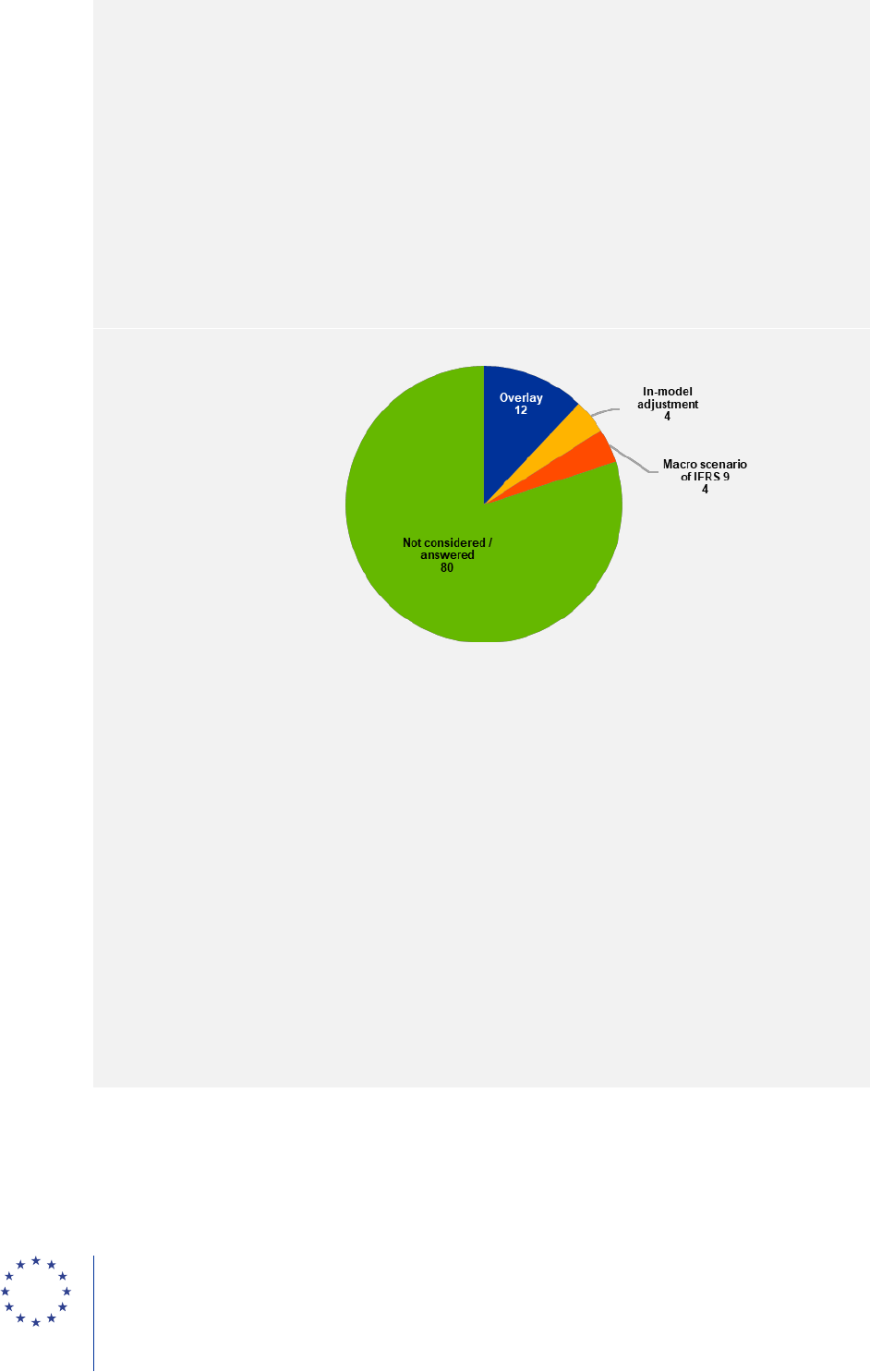
Climate-related risks and accounting April 2024
Main issues identified
25
as quantitative data for in-model adjustments and other relevant variables (including overlays),
governance and control processes in place, and collective staging. A key finding was that banks
lack the historical data on which classical expected loss provisioning models can be run.
80% of the banks responded that climate-related risks were still not considered in their
expected credit loss models (Chart A). This proportion is much larger than in the case of other
emerging risk factors such as energy supply or inflation. As for how banks incorporate climate-
related risks into expected credit loss models, 12% do so through overlays, 4% via in-model
adjustments (rating override) and 4% through the macroeconomic scenarios.
Chart A
How climate-related risks are included in expected credit loss models
(percentages)
Sources: McCaul and Walter (2023).
Within the group of banks that already incorporate climate-related risks in their expected
credit loss models, some best practices can be found. Regarding in-model adjustments, banks
introduce climate-related risks through rating override of clients belonging to problematic sectors,
using tools that project impacts on cash flows and financial ratios at entity level. Other banks
introduce climate-related risks through the macroeconomic scenario, based on the assumption that
their baseline scenarios include, as qualitative elements, factors such as developments of CO2
prices and political interaction to reach the climate targets.
Banks applying overlays generally do so at total expected credit loss level, identifying
specific sectors and determining the overlays based on expert judgement. As opposed to
such “umbrella overlays”, it would seem preferable for banks to apply overlays at PD or LGD level,
resulting from models or simulations that consider, for instance, different scenarios on the transition
towards fully electric vehicles, or that apply shifts to PD curves based on scores that capture
exposures to physical and transition risks.
Similarly, insurance corporations need to consider the effect of climate-related risks when
estimating the future cash flows of their insurance contracts. IFRS 17 Insurance Contracts
explicitly requires that estimates of future cash flows “reflect conditions existing at the measurement

Climate-related risks and accounting April 2024
Main issues identified
26
date, including assumptions at that date about the future” and that the expected value (i.e. the
probability-weighted mean) takes into account the full range of possible outcomes.
56
The scenarios
developed must include unbiased estimates of the probability of catastrophic losses and reference
is made to catastrophe bonds and weather derivatives.
57
Typically, under IFRS 17, models used for
the computation of future cash flows from insurance contracts use, among other inputs, data from
the recent past, adjusted if “there are indications that historical trends will not continue, that new
trends will emerge or that economic, demographic and other changes may affect the cash flows”.
58
In some circumstances, such as catastrophe risks, relying excessively on past data could lead to
inaccurate estimates of future insurance liabilities. This is particularly relevant because IFRS 17
does not allow for the recognition of catastrophe provisions and/or equalisation provisions (in other
words, provisions generally build up over years, usually following a prescribed regulatory formula,
so they can be released in years when claims exceed the normal trends).
59
Only in cases where an
insurance corporation is particularly risk-averse and requires very large compensation for bearing
insurance risks could the related risk adjustment be tantamount to a catastrophe or equalisation
provision. In any event, as natural disasters become more frequent in the future, issues concerning
the insurability of the effects of these disasters will emerge and new solutions will be needed.
60
It may be operationally difficult for banks and insurers to incorporate climate-related risks in
their models and, consequently, a scenario where estimates of expected credit losses or the
value of insurance contracts are sharply adjusted due to the materialisation of certain
climate-related risks cannot be entirely ruled out. Despite intensive work by the scientific
community in recent years, considerable uncertainty remains about the timing and severity of the
materialisation of climate-related risks. For banks, expected credit loss models typically forecast
three years ahead, which may be too short a horizon to cater for most climate-related risks.
Furthermore, uncertainty increases with contracts that have longer terms, which is often the case in
the insurance sector. Quantifying the impact of climate-related risks on growth or employment is
also subject to great uncertainty (Basel Committee on Banking Supervision, 2021). Accordingly,
banks and insurance corporations may be faced with the daunting task of having to frequently
review and update their models to account for climate-related factors, including data that are
accurate and granular enough to capture the related risks.
61
This would be particularly relevant in
the case of transition risks, where institutions would need to react quickly to incorporate newly
available data into their models.
56
See IFRS 17.33.
57
See IFRS 17.B40 and IFRS 17.B41.
58
See IFRS 17.B41.
59
For example, consider an annually renewable insurance contract covering a European policyholder against damage
caused by tornadoes. The event has a low frequency (1/100) and a high severity (CU100). In other words, the event is
expected to occur once every 100 years with an expected loss of CU100. Each year the insurer collects a premium of
CU100*1/100=CU1, which is the fulfilment cash flow of the contract (no acquisition costs, no profit margin, no risk
adjustment for non-financial risk and no discounting is considered). If no tornadoes occur in a given year, CU1 turns into
profit. However, if a tornado does occur, then the insurer bears a CU100 loss. A fair consideration of risk factors should
require the building up of a provision in the years without tornadoes, with no profit registered.
60
Some initiatives imply the pooling of interests, such as in the case of products currently offered in the Netherlands to insure
against the effects of terrorism, or newly designed laws and regulations that are complemented with insurance products.
61
For example, the energy certification of individual real estate assets used as collateral in mortgage loans.

Climate-related risks and accounting April 2024
Main issues identified
27
3.4 Disclosures
Efforts should be made to enhance disclosures about how climate-related risks are reflected
in the financial statements, as a way to ensure transparency towards market participants.
IFRS accounting standards contain implicit requirements to disclose relevant information connected
with climate-related risks (e.g., the importance of climate-related risks when determining
impairment of intangible assets with an indefinite useful life). However, those requirements may go
unnoticed and become ineffective, particularly when compliance by reporting entities is driven by a
strong judgemental component, and also considering that IAS 1 allows entities not to disclose
certain information if it is considered immaterial. This puts the onus on enforcing appropriate
interpretation and application of IFRS accounting standards to foster transparency of accounting
information. For example, climate factors can be important in determining the useful life of assets
that are key to non-financial corporations operating in sectors heavily exposed to climate-related
risks. In those cases, the absence of a coherent disclosure requirement could make it harder for
users of financial statements to interpret the information they contain and lead to less informed
economic decisions. Turning to financial institutions, there is no specific reference to the effects of
climate-related risks in IFRS 7. Therefore, it could be difficult for users to understand the extent of
the qualitative and quantitative impact of climate-related risks on the fair value of financial
instruments, the estimation of expected credit losses or the assessment of a significant increase in
credit risk. Furthermore, given that financial instruments classified as Level 3 are based on the
entity’s own models, data and assumptions, disclosures on unobservable inputs used to determine
their fair value should also include assumptions regarding how market participants include climate-
related factors when pricing risks.
Expanding the existing disclosure requirements without proper consideration of the
underlying estimates and data sources may not be sufficient and could even have adverse
consequences for users of financial statements. Even though disclosure requirements aimed at
providing relevant, meaningful and reliable information regarding the impact of climate-related risks
on the reporting entity are desirable, an overdose of boilerplate disclosures would not be conducive
to higher transparency and may hamper financial stability in the long term. Given the existing
uncertainty about the financial impact of climate-related risks, disclosures about the estimates and
data sources used by reporting entities are critical for users of financial statements to understand
the potential limitations of the information disclosed. Understanding the methodologies and data
used to value assets and liabilities may be as important as the valuation itself. This should be the
main focus for enhancing current disclosures, as users that are unable to understand how these
estimates have been made may make wrong decisions, leading to suboptimal outcomes.
62
In turn,
poor disclosure regarding the impact of climate-related risks could make it harder for preparers and
users of financial statements to retrieve information that feeds into the fair valuation of financial
instruments issued, underwriting, pricing or estimation of credit losses.
Moving to initiatives in the private sector, both the Task Force on Climate-related Financial
Disclosures (TCFD) and Carbon Tracker still find much room for improvement. The TCFD
published a set of recommendations on climate-related financial risk disclosures in 2017, aimed at
62
As already mentioned, given the considerable uncertainty about the timing and extent of climate-related risks, there would,
in the absence of clear and detailed explanations of how estimates are made, be no benchmark available for users of
financial statements to judge whether an estimate is sound or poor.

Climate-related risks and accounting April 2024
Main issues identified
28
allowing decision-useful and forward-looking information to be provided alongside financial
information from a broad range of reporting entities.
63
These recommendations are grouped around
four areas: governance, strategy, risk management, and metrics and targets.
64
The 2022 TCFD
Status Report finds that, while substantial progress has been made since the recommendations
were issued, there is a need for more urgent progress in this area (Task Force on Climate-related
Financial Disclosures, 2022). Carbon Tracker
65
has published two reports assessing the extent to
which non-financial corporations with extensive use of carbon make adequate climate-related
disclosures (Davidson and Schuwerk, 2021 and 2022). The latest report finds that “[non-financial
corporations] failed to disclose the relevant quantitative climate-related assumptions and estimates
used to prepare the financial statements, even when they indicated that climate-related risks may
impact these assumptions” and that “no company used assumptions and estimates that were
aligned with achieving net zero by 2050 or sooner”. It also notes that their “financial statements
failed to fully reflect climate considerations included in the companies’ other reporting”, pointing
directly to the issue of connectivity between accounting and sustainability standards.
Failing to ensure connectivity between accounting and sustainability standards can have a
negative effect on the quality of the information disclosed to capital markets, with
potentially system-wide consequences. In general, information disclosed in the financial
statements should be comprehensible on a standalone basis. Market participants should be aware
of the characteristics of such information and the differences with respect to sustainability
information (e.g., backward- and forward-looking, respectively), so as to be able to factor those
differences into their economic decisions. However, in a scenario where information prepared
under sustainability standards is not fully aligned with the information prepared according to
accounting standards, market participants may become confused and unsure about which
information they should be relying on when making their economic decisions. This could also be the
case where unbalanced emphasis is placed on disclosures in either the financial statements or the
non-financial part of the annual report, or if material information that should be disclosed in the
financial statements is only disclosed through sustainability reporting, thus creating gaps. In any of
these situations, inconsistent reporting requirements would create confusion among users of
financial statements, who could thus adopt suboptimal economic decisions, potentially inducing
system-wide consequences, as outlined in Section 2.2 above.
63
The TCFD was set up by the Financial Stability Board to improve the reporting of climate-related financial information. In
2023, the FSB asked the IFRS Foundation to take over the monitoring of climate-related disclosures in the financial
statements and the TCFD was disbanded in October 2023.
64
For further information on these recommendations, see Task Force on Climate-related Financial Disclosures (2017).
65
Carbon Tracker is an independent think tank that carries out in-depth analysis of the impact of energy transition and high-
cost, carbon-intensive fossil fuels on capital markets.

Climate-related risks and accounting April 2024
Conclusions and policy discussion
29
Existing uncertainty about the materialisation of climate-related risks, the varied
understanding of the concept, and the lack of sound methodologies for estimating the
financial impact of these risks define how climate factors are currently being incorporated
into (i) market prices, (ii) the valuation of non-financial assets and liabilities, and (iii)
macroeconomic and other models.
66
The IFRS accounting standards directly affected (IAS 36
Impairment of Assets, IAS 37 Provisions, Contingent Liabilities and Contingent Assets, IFRS 9
Financial Instruments, IFRS 13 Fair Value Measurement, and IFRS 17 Insurance Contracts) rely
heavily on estimates by market participants (e.g. on the fair value of a Level 1 and, to a certain
extent, Level 2 financial instruments) or by management of the reporting entities themselves (e.g.
impairment of property, plant and equipment, or the estimation of environmental liabilities). Given
the principles-based nature of IFRS accounting standards, preparers of financial statements are
confronted with the difficult task of assessing the financial impact of climate-related risks and
reflecting that impact in their financial statements, and such difficulty is compounded by the lack of
commonly accepted and sound methodologies in that regard and by the fact that these risks are
interpreted differently among stakeholders.
67
In that sense, it would be desirable to maintain or step
up efforts to develop methodologies capable, on a proportionate basis, of objectively gauging the
impact of climate-related risks, in order to ensure comparability and aggregation of the impacts
disclosed by individual institutions.
Delayed recognition of climate-related risks in the financial statements could contribute to
“information shocks”, potentially affecting financial stability. IFRS accounting standards do
not refer explicitly to climate-related risks, and a lack of relevant guidance could result in their
unsatisfactory application, leading to an overestimation of assets, underestimation of liabilities or
deferral of losses. When climate-related risks materialise, or simply if financial market participants
become aware of the magnitude of these risks and reassess their expectations, a sudden
adjustment of the affected elements within the financial statements (i.e. an “information shock”)
could trigger deleveraging, fire sales or a credit crunch to absorb the related losses.
68
Uncertainty,
lack of data, the sheer variety of risk factors that fall within the “climate-related risk” label and
interconnectedness among institutions are all factors that could amplify the impact of climate-
related risks on the financial system.
69
Looking at their design, IFRS accounting standards generally allow an entity to reflect
climate-related risks in the financial statements, subject to the boundaries of financial
reporting. The four issues described in Section 3 can be placed in a continuum, ranging from the
design of accounting standards by the IASB to the assessment of their implementation, which is
usually a task that falls within the realm of audit assurance or accounting enforcement. Considering
66
This is reflected in ESRS E1 AR66 and AR67.
67
For instance, Financial Stability Board (2020b) provides a stock-take of the approaches followed by financial authorities to
incorporate climate-related risks. Among its findings, it highlights the differences in these approaches and the lack of
common definitions, scope and methodologies for quantifying how climate-related risks affect financial institutions.
68
See Pérez Rodríguez (2021).
69
See, among others, Boushey et al. (2021), Li et al. (2021), European Central Bank and European Systemic Risk Board
(2022 and 2023) and Dubiel-Teleszynski (2022).
4 Conclusions and policy discussion

Climate-related risks and accounting April 2024
Conclusions and policy discussion
30
how the standards are designed, there seems to be no need to undertake a major revision to
enhance the way climate-related risks should be reflected in IFRS financial statements. IFRS
accounting standards are principles-based and should therefore provide enough flexibility for
reporting entities to reflect their climate-related exposures.
However, the ESRB has identified amendments to existing IFRS accounting standards that
could be beneficial for users of financial information and, indirectly, financial stability. These
amendments, which are broadly aligned with those already identified by the IASB (International
Accounting Standards Board, 2023), are briefly explained below:
(a) The application of the materiality principle in IAS 1 Presentation of Financial Statements
may need to be enhanced, as even if the transaction involved is immaterial in
quantitative terms, user expectations or peer practice may justify its disclosure. In this
sense, the assessment of materiality should not be overly reliant on quantitative
thresholds and could also consider how the uncertainty affecting relevant elements in the
financial statements may play out over the long term.
(b) Climate factors could be mentioned as one of the indicators of impairment in paragraph
12 of IAS 36 Impairment of Assets.
(c) IAS 37 Provisions, Contingent Liabilities and Contingent Assets could be amended along
three lines. First, guidance would be welcome on how the standard’s principles should
be applied in the context of transition risks, particularly as concerns how new
environmental regulations or commitments fall under its scope (e.g., how commitments
to net zero emissions are reflected through the recognition of provisions or contingent
liabilities). Second, relevant examples of climate-related provisions and contingent
liabilities should be introduced. Third, disclosure requirements should be amended to
add detail and granularity on expected or committed liabilities arising from climate-
related risks.
(d) The estimation and assessment of the implications of climate-related risks could be
improved by providing examples and application guidance on how those risks should be
incorporated into the estimation of expected credit losses and the fair valuation of
financial instruments, and on specific disclosure requirements within IFRS 7 Financial
Instruments: Disclosures and IFRS 13 Fair Value Measurement. In particular, climate-
related factors could be introduced into the non-exhaustive list of information that may be
relevant for assessing a significant increase in credit risk (paragraph B5.5.17 of IFRS 9
Financial Instruments).
Additionally, the IASB should revisit and prioritise work on the accounting treatment of
pollutant-pricing (i.e. carbon-pricing) mechanisms.
70
Currently, there is no specific guidance on
the accounting of CO2 certificates, licences or trading schemes, and IAS 37 does not provide
sufficient clarity to preparers of financial statements. As these mechanisms are expected to
become increasingly important in the future, the absence of a clear accounting treatment may lead
70
The IASB already conducted research in this field in 2015 (see International Accounting Standards Board, 2016).

Climate-related risks and accounting April 2024
Conclusions and policy discussion
31
to diversity in practice and affect the performance of reporting entities (through reduced margins,
increased impairments or provisions), with a potential impact on financial stability.
Turning to the implementation of IFRS accounting standards, there could be some
measures with clear financial stability benefits when it comes to disclosure and expected
credit losses. Implementation of IFRS accounting standards can vary across reporting entities and
EU jurisdictions and the ESRB does not have an explicit mandate for carrying out a detailed cross-
country assessment. However, steps could be taken to better reflect the impact of climate-related
risks when implementing IFRS, which would certainly be beneficial for financial stability.
71
For
instance, there could be merit in developing examples of best practice climate-related risk
disclosures to be included in the financial statements of both financial institutions and non-financial
corporations. The recent report by ESMA, focused on disclosures by non-financial corporations, is
a welcome addition (European Securities and Markets Authority, 2023c). Regulators,
microprudential supervisors and/or accounting enforcers could also consider developing guidance
on how climate-related risks can affect the expected credit loss estimates of banks under their
remit, ensuring that they adequately reflect both the banks’ and their borrowers’ exposures to
climate-related risks. In this regard, consideration of the borrower’s sector of activity and the
sector’s exposure to climate-related risks could be important, as could possible changes in the
value of the real estate posted as collateral. Another area of increasing importance for
microprudential supervisors refers to the computation of cash flows from certain insurance
contracts directly exposed to climate factors, including natural catastrophe events and home
insurance in areas most vulnerable to climate-related events.
72
In line with the FSB roadmap on climate change (Financial Stability Board, 2023), accounting
and sustainability standard-setters should continue their work around connectivity. Given
the boundaries of accounting, sustainability standards are crucial for disclosing the long-term
financial impacts of climate-related risks. The entry into force of sustainability standards (ESRS and
also those issued by the ISSB) might raise questions among preparers and users of financial
statements on how the information prepared according to accounting and sustainability standards
should interact. In the EU, that would refer to how the requirement in ESRS to connect
sustainability information with the financial statements is applied in practice. In this regard, further
work on connectivity, involving also the accounting side, would help to ensure that the desired
outcomes (in terms of richer information on the impact of climate-related risks) are accomplished,
while avoiding confusion and inconsistency in the information disclosed.
The scope and work of auditors is crucial, including their role following the entry into force
of ESRS. Currently, auditors are required to express an opinion on the financial statements,
including disclosures. As such, they can play an important role, particularly when assessing existing
disclosures on climate-related risks in the financial statements. In particular, auditors should be in a
position to challenge the estimations disclosed by reporting entities on the impact of climate-related
risks. Meanwhile, there are other parts of the annual report that are of a non-financial nature and
71
These amendments, with a clear financial stability component, should be assessed in line with the overall objective of the
IFRS Foundation (i.e., “to require high quality, transparent and comparable information in financial statements and other
financial reporting to help investors, other participants in the world's capital markets and other users of financial information
make economic decisions”). Similarly, singling out climate-related risks should not be interpreted as giving less importance
to other risks to which reporting entities may be exposed.
72
See, for example, recent dynamics in home insurance in Florida (5 trends to watch in 2024 with Florida's property
insurance market).

Climate-related risks and accounting April 2024
Conclusions and policy discussion
32
are not subject to audit scrutiny. Information contained in non-financial reporting, such as transition
plans, may be extensive as regards climate-related risks, but concerns over its reliability may arise
if it is not verified by an independent third party. This may become increasingly important as the
process of adopting ESRS within the EU moves forward.
73
Leaving this information fully outside of
the scope of the statutory audit may impair the quality and transparency of financial information.
Furthermore, the requirement of audit assurance for sustainability reporting could be a useful tool in
addressing the lack of connectivity between accounting and sustainability standards. In this regard,
a welcome development is the July 2023 public consultation of the International Auditing and
Assurance Standards Board (IAASB) on a draft International Standard on Sustainability Assurance
(ISSA), which covers general requirements for sustainability assurance engagements and marks
the first step towards equipping auditors with a common approach to the assurance of sustainability
information.
74
In the EU, further work by the Committee of European Audit Oversight Bodies
(CEAOB) to harmonise practices on assurance during the first years of implementation of ESRS
could be key in ensuring that sustainability reporting leads to the disclosure of more accurate and
comprehensive information on the impact of climate-related risks on reporting entities.
73
There is an assurance requirement in the Corporate Sustainability Reporting Directive for sustainability statements
prepared using ESRS. Limited assurance will be in place from the initial application of ESRS, and by October 2026 the
Commission will adopt mandatory limited assurance standards. Following a review in 2027, the Commission may adopt
reasonable assurance standards by October 2028.
74
See Public consultation ISSA 5000.

Climate-related risks and accounting April 2024
References
33
Anderson, N. (2019), IFRS Standards and climate-related disclosures, November.
Basel Committee on Banking Supervision (2021), Climate-related risk drivers and their
transmission channels, April.
Battiston, S., Mandel, A., Monasterolo, I., Schütze, F. and Visentin, G. (2017), “A climate stress-
test of the financial system”, Nature Climate Change, Vol. 7, Issue 4, pp. 283-288.
Boushey, H., Kaufman, M. and Zhang, J. (2021), “New tools needed to assess climate-related
financial risk”, Issue Brief, The White House, 3 November.
Christensen, H. and Nikolaev, V. (2013), “Does fair value accounting for non-financial assets
pass the market test?”, Review of Accounting Studies, Vol. 18, pp. 734-775.
Davidson, B. and Schuwerk, R. (2022), Still flying blind: The absence of climate risk in
financial reporting, Carbon Tracker Initiative, October.
Davidson, B. and Schuwerk, R. (2021), Flying blind: The glaring absence of climate risks in
financial reporting, Carbon Tracker Initiative, September.
Denkstatt (2023), European Sustainability Reporting Standards (ESRS) in a nutshell, 22
August.
Dubiel-Teleszynski, T., Franch, F., Fukker, G., Miccio, D., Pellegrino, M. and Sydow, M. (2022),
“System-wide amplification of climate risk”, Macroprudential Bulletin, European Central Bank,
June.
EFRAG (2023), Connectivity between Financial and Sustainability Reporting Information –
Suggested scope and approach of EFRAG Research project, February.
EFRAG (2021), EFRAG PTF-NFRS report – Appendix 4.4 Interconnection between financial
and non-financial information, March.
Eren, E., Merten, F. and Verhoeven, N. (2022), “Pricing of climate risks in financial markets: a
summary of the literature”, BIS Papers, No 130, Bank for International Settlements.
European Banking Authority (2023), Report on the role of environmental and social risks in the
prudential framework, October.
European Central Bank and European Systemic Risk Board (2023), Towards macroprudential
frameworks for managing climate risk, December.
European Central Bank and European Systemic Risk Board (2022), The macroprudential
challenge of climate change, July.
References

Climate-related risks and accounting April 2024
References
34
European Commission (2020), Consultation on a renewed sustainable finance strategy –
summary of responses.
European Insurance and Occupational Pensions Authority (2023), Consultation Paper on the
prudential treatment of sustainability risks, December.
European Securities and Markets Authority (2023a), 2022 Corporate reporting enforcement and
regulatory activities, March.
European Securities and Markets Authority (2023b), 27th Extract from the EECS’s Database of
Enforcement, March.
European Securities and Markets Authority (2023c), The heat is on: disclosures of climate-
related matters in the financial statements, October.
European Securities and Markets Authority (2023d), Consultation paper draft guidelines on
enforcement of sustainability information, December.
European Securities and Markets Authority (2022), European common enforcement priorities
for 2022 annual financial reports, October.
European Securities and Markets Authority (2021), European common enforcement priorities
for 2021 annual financial reports, October.
European Systemic Risk Board (2023), Vulnerabilities in the EEA commercial real estate
sector, January.
European Systemic Risk Board (2021a), Financial stability implications of IFRS 17 Insurance
Contracts, December.
European Systemic Risk Board (2021b), Climate-related risk and financial stability, July.
European Systemic Risk Board (2020a), Macroprudential implications of financial instruments
in Levels 2 and 3 for accounting purposes, February.
European Systemic Risk Board (2020b), Positively green: measuring climate change risks to
financial stability, June.
European Systemic Risk Board (2019a), Expected credit loss approaches in Europe and the
United States: differences from a financial stability perspective, January.
European Systemic Risk Board (2019b), The cyclical behaviour of the ECL model in IFRS 9,
March.
European Systemic Risk Board (2017), Financial stability implications of IFRS 9, July.
Financial Stability Board (2023), FSB roadmap for addressing financial risks from climate
change – 2023 progress report, July.

Climate-related risks and accounting April 2024
References
35
Financial Stability Board (2020a), The implications of climate change for financial stability,
November.
Financial Stability Board (2020b), Stocktake of financial authorities’ experience in including
physical and transition climate risks as part of their financial stability monitoring, July.
International Financial Reporting Standards Foundation (2023), Effects of climate-related matters
on financial statements, November.
International Accounting Standards Board (2023), “Climate-related risks in the financial
statements”, Staff Paper, September.
International Accounting Standards Board (2016), “Pollutant pricing mechanisms”, Staff Paper,
April.
Li, H-M., Wang, X-C., Zhao, X-F. and Qi, Y. (2021), “Understanding systemic risk induced by
climate change”, Advances in Climate Change Research, Vol. 12, Issue 3, pp. 384-394.
Martínez, C. and Pérez Rodríguez, P. (2023), “Climate change, financial risks and reporting:
Distant horizons?”, Financial Stability Review, Issue 44, Banco de España.
McCaul, E. and Walter, S. (2023), “Overlays and in-model adjustments: identifying best
practices for capturing novel risks”, The Supervision Blog, European Central Bank, 26 May.
Olante, M.E. and Lassini, U. (2022), “Investment property: Fair value or cost model? Recent
evidence from the application of IAS 40 in Europe”, Advances in Accounting, Vol. 56, 100568.
Pérez Rodríguez, P. (2021), “Accounting and auditing of credit loss estimates: The hard and
the soft”, Latin American Journal of Central Banking, Vol. 2, Issue 2, 100027.
Stroebel, J. and Wurgler, J. (2021), “What do you think about climate finance?”, Journal of
Financial Economics, Vol. 142, No 2, pp 487-498.
Task Force on Climate-related Financial Disclosures (2022), 2022 Status Report, October.
Task Force on Climate-related Financial Disclosures (2017), Recommendations of the Task
Force on Climate-related Financial Disclosures – Final report, June.

Climate-related risks and accounting April 2024
Annex 1: Work on climate-related risks by ESMA in its role as coordinator of accounting enforcers
36
ESMA’s responsibilities in the realm of corporate reporting are focused mainly on ensuring
convergence in supervisory practices and outcomes, i.e. promoting harmonised practices
when European enforcers examine information disclosed by issuers and when they take
enforcement decisions. ESMA is heavily invested in enhancing the quality of corporate reporting
(and thus contributing to investor protection) by publishing statements, recommendations and
reports to issuers (including audit committees) and auditors and by responding to consultations
received from standard-setters and other relevant bodies. ESMA also actively contributes to the
development and maintenance of the relevant financial and sustainability reporting standards and
provides opinions on the draft European Sustainability Reporting Standards prior to their adoption
by the European Commission. ESMA does not, however, have direct supervisory powers over the
regulated information disclosed by issuers in the European Economic Area (EEA), this being the
task of European national enforcers for both financial and non-financial information.
European Common Enforcement Priorities
Establishing European Common Enforcement Priorities (ECEP) is an important way of
fostering supervisory convergence across the EEA. ESMA has been developing these priorities
on an annual basis since 2012. It has found that communicating them to issuers, auditors and
investors before their annual financial statements are prepared helps to prevent misstatements and
to enhance quality and consistency of reporting. To this end, ESMA issues a statement regarding
financial and non-financial information in the third quarter of each year, normally towards the end of
October. Following the publication of the ECEP, European enforcers (i) include them in their annual
work plan for the next year, (ii) select issuers for examination for whom the ECEP topics are
material, (iii) assess how issuers have adhered to ESMA’s recommendations, and (iv) take action
when misstatements are encountered. The results of these assessments (including information
regarding the actions taken) are published in ESMA’s report on corporate reporting enforcement
and regulatory activities.
75
ESMA has identified climate-related matters with regard to financial information as an
enforcement priority for annual reports covering the years 2021, 2022 and 2023. In particular,
ESMA and enforcers have highlighted the need for issuers to be transparent and to enhance
disclosures regarding the impact of climate-related risks and opportunities in the following areas:
1. accounting policies, significant judgements and estimation of uncertainty;
2. impairment of assets;
3. revision of useful lives of non-current assets;
75
See European Securities and Markets Authority (2023a).
Annex 1: Work on climate-related risks by ESMA
in its role as coordinator of accounting enforcers

Climate-related risks and accounting April 2024
Annex 1: Work on climate-related risks by ESMA in its role as coordinator of accounting enforcers
37
4. accounting of power purchase agreements;
5. recognition of provisions, contingent liabilities and contingent assets;
6. specific considerations for financial institutions.
ESMA has also identified climate-related matters with regard to non-financial information as
an enforcement priority for the 2021, 2022 and 2023 reporting periods. In particular, ESMA
and enforcers have highlighted the need for issuers to enhance disclosures in the following areas:
1. policies relating to climate matters and related outcomes;
2. metrics and targets, and specifically greenhouse gas (GHG) emissions;
3. climate goals and related transition plans;
4. materiality process for the identification of climate-related risks and opportunities;
5. disclosures pursuant to Article 8 of the Taxonomy Regulation.
In 2022 ESMA highlighted that issuers should pay particular attention to climate-related
matters affecting the development, performance, risks and uncertainties of their businesses.
They should also consider whether the emphasis placed on climate-related matters in the
management report and the non-financial information is consistent with the extent of disclosure in
their IFRS financial statements. In this context, enforcers would challenge disclosures related to
climate-related risks to identify and prevent potential greenwashing.
76
In 2023 ESMA reiterated that
issuers should use consistent assumptions between their IFRS financial statements and the non-
financial information they disclose. They should also explain material deviations between the
assumptions used in impairment tests and provisions and their climate-related commitments, plans
or strategy.
ECEP assessment
In March 2023 ESMA published the results of issuers’ adherence to the 2022 ECEP, which
showed significant room for improvement in disclosures relating to the impacts of climate-
related risks and opportunities in annual financial reports.
77
With respect to financial
information, ESMA highlighted that enforcers did not identify significant inconsistencies and/or
contradictions between the information disclosed in management reports and the information
contained in financial statements. However, they did find that information regarding climate-related
matters in financial statements was often incomplete or missing altogether. This was particularly
concerning when the issuer operated in a sector that was expected to be heavily affected by
76
Many of the commitments to reach targets related to climate-related risks are made in the context of voluntary “climate
reports” or “sustainability reports”, so accounting enforcers may have limited powers to assess how realistic they are and
the extent to which they are supported by relevant action plans.
77
See European Securities and Markets Authority (2023a).

Climate-related risks and accounting April 2024
Annex 1: Work on climate-related risks by ESMA in its role as coordinator of accounting enforcers
38
climate-related risks or was located in areas where climate-related risks were expected to be
relevant. In particular, ESMA identified shortcomings on disclosures:
• when forward-looking assumptions were necessary, such as in recoverable amount
calculations;
• regarding major sources of estimation uncertainty and judgements;
• in the accounting treatment of carbon and greenhouse gas emissions trading schemes,
particularly when they affect issuers’ financial performance and position.
Following their examination of 2021 financial statements, enforcers took seven actions to
address misstatements when accounting for climate-related risks in financial statements
prepared in accordance with IFRS accounting standards.
78
In relation to 18 issuers, enforcers
did not take any enforcement action but informed the issuers concerned about areas for future
improvement in their disclosures. These concerned (i) progress made against climate-related
targets; (ii) sensitivity analysis on the materialisation of climate-related risk events; (iii) additional
explanation of climate-related factors considered when checking for indicators of impairment; (iv)
disclosure of main judgements, major sources of uncertainty; and (v) consideration of climate-
related risks in the key assumptions used.
With respect to non-financial information, the findings in relation to climate-related matters
indicated that some issuers still do not report on such matters for no clear reason and that
disclosures are not satisfactory in a number of areas, most notably:
1. consistency amongst objectives, targets, policies, actions, outcomes and key performance
indicators;
2. Scope 3 emission disclosures;
3. segment information for GHG emission metrics;
4. alignment of emission patterns with the Paris Agreement;
5. progress made towards pre-set emission-reduction targets;
6. resilience and management of physical or transition risks;
7. mitigation measures vis-à-vis climate-related impacts;
8. financial consequences of climate change;
9. due diligence processes related to climate policies, including details concerning internal
processes and the definition of specific KPIs;
10. forward-looking information on how the issuer intends to progress towards addressing climate-
related matters.
78
Please refer to decisions 7 and 8 of European Securities and Markets Authority (2023b).

Climate-related risks and accounting April 2024
Annex 1: Work on climate-related risks by ESMA in its role as coordinator of accounting enforcers
39
After examining disclosures of climate-related matters in the 2021 non-financial statements,
European enforcers took 12 enforcement actions. The actions taken addressed (i) additional
information regarding sustainable accounting policies to accompany the sustainability data
disclosed; (ii) additional information on environmental policies; (iii) reporting perimeters; (iv) KPIs
and objectives; (v) GHG emissions segmentation and Scope 1, 2 and 3 breakdowns, including
additional explanations on issuers’ phases of the value chain; and (vi) consistency of information
provided on issues related to climate and information regarding issuers’ progress towards emission
targets set in 2021.
As mentioned above, climate-related recommendations continued to be prioritised in the
2023 ECEP. ESMA therefore urged issuers to further improve their disclosures related to climate-
related matters when preparing both IFRS financial statements and non-financial statements. This
should enable investors to understand the impacts of climate-related matters on the issuers’
financial position, financial performance and cash flows. ESMA will publish the results of the 2023
ECEP assessment in 2024 and possibly include further recommendations.
Report titled “The heat is on: disclosures of climate-related
matters in the financial statements”
In October 2023 ESMA published a report providing illustrative examples on how issuers
may consider climate-related matters in their IFRS financial statements (European Securities
and Markets Authority, 2023c). The report addresses disclosures, touching upon the following
areas, among others: (i) significant judgements, major sources of estimation uncertainty and
accounting policies; (ii) impairment of non-financial assets; (iii) useful lives of tangible and
intangible assets; and (iv) provisions. Aside from the examples, certain areas for further attention
are identified, as they may provide further insights on how issuers could improve the quality of the
information they disclose in their financial statements. The report aims to assist issuers in preparing
their 2023 annual financial reports, in particular, by providing entity-specific and useful information
to users of financial statements.
Next steps
In light of the shortcomings identified when assessing the 2022 ECEP in relation to financial
reporting, ESMA has set up a group to focus on the supervision of climate-related matters in
IFRS. In addition, it regularly liaises with audit networks and the IASB on how issuers are taking
climate-related risks into account. ESMA will continue to monitor and, where relevant, contribute to
the initiatives of standard-setters in this area and provide further guidance to the market.
In 2018 ESMA set up a specific working group enabling European national enforcers to
discuss supervisory cases and develop recommendations in relation to non-financial
reporting. Since 2022 this group has also been looking to improve the standard-setting process for
both European Sustainability Reporting Standards and IFRS sustainability standards. In 2023
ESMA continued to promote discussion of supervisory cases in relation to sustainability reporting,
coordinate the review of reporting practices in this area and draw up recommendations for the 2023

Climate-related risks and accounting April 2024
Annex 1: Work on climate-related risks by ESMA in its role as coordinator of accounting enforcers
40
enforcement priorities. In the second half of 2023 ESMA and the national competent authorities
conducted a fact-finding exercise on a limited sample of European issuers in relation to the
reporting of environmentally sustainable business activities pursuant to Article 8 of the Taxonomy
Regulation. In 2024 ESMA plans to finalise its Guidelines on the Enforcement of Sustainability
Information following a public consultation.
79
These Guidelines aim to achieve further convergence
in the supervision and enforcement of sustainability statements prepared in accordance with ESRS
and which include information related to the Taxonomy Regulation.
79
See European Securities and Markets Authority (2023d).

Climate-related risks and accounting April 2024
Annex 2: ESRS E1 Climate change
41
The first set of European Sustainable Reporting Standards (ESRS) was published by the
European Commission in July 2023, with ESRS E1 being devoted to climate change.
80
ESRS
must be applied by all entities subject to the Corporate Sustainability Reporting Directive (CSRD)
and cover a full range of environmental, social and governance issues, including climate change,
biodiversity and human rights (Figure A1).
81
ESRS E1 focuses on climate change, with the main
objective of allowing users of sustainability statements to understand (i) how the entity affects
climate change, in terms of material positive and negative actual and potential impacts; (ii) the
entity’s past, current and future mitigation efforts in line with the Paris Agreement and in limiting
global warming to 1.5°C; (iii) the entity’s plans and capacity to adapt its strategy and business
model(s) in line with the transition to a sustainable economy and to contribute to limiting global
warming to 1.5°C; (iv) any other actions taken, and the result of such actions, to prevent, mitigate or
remediate actual or potential negative impacts; (v) the nature, type and extent of the entity’s
material risks and opportunities arising from impacts and dependencies on climate change, and
how they are managed; and (vi) the financial effects over the short, medium and long term of risks
and opportunities arising from the entity’s impacts and dependencies on climate change.
80
The full text of ESRS E1 is available in Annex 1 of Commission Delegated Regulation 2023/2772.
81
ESRS use the term “undertakings” to refer to those institutions under their scope. To keep alignment with the terminology
used in IFRS accounting standards, “entity” is used throughout the text.
Annex 2: ESRS E1 Climate change
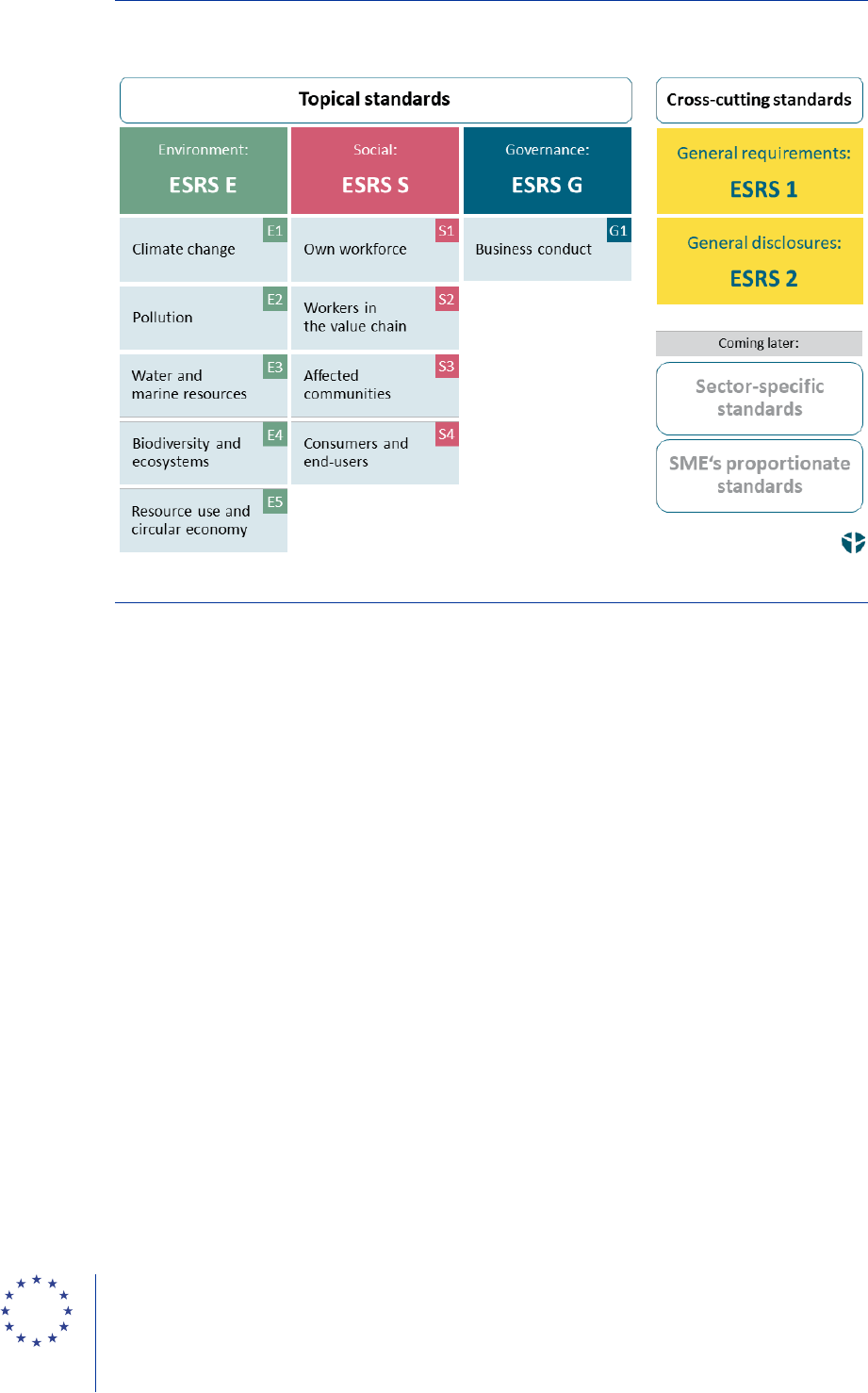
Climate-related risks and accounting April 2024
Annex 2: ESRS E1 Climate change
42
Figure A1
Overview of ESRS
Source: Denkstatt (2023).
The requirements in ESRS E1 relate to disclosure requirements in other ESRS and to
requirements at a global level. ESRS E1 interacts with other environmental ESRS (ESRS 2 to
ESRS 5) and must be applied in conjunction with the disclosure requirements of ESRS 2 on
general disclosures on matters such as the integration of sustainability-related performance in
incentive schemes or the description of processes to identify and assess material climate-related
impacts, risks and opportunities. The disclosure requirements in ESRS E1 cover virtually all
disclosure requirements of the standards issued by the ISSB and of the standards prepared by the
Securities and Exchange Commission in the United States. Compared to ISSB standards, ESRS
come with additional discourse requirements on anticipated financial effects and impact-related
disclosures.
Following the CSRD requirement, ESRS E1 requires entities to disclose detailed information
on their transition plans to a sustainable economy, in line with the Paris Agreement and the
objective of reaching climate neutrality by 2050. Entities should include an explanation as to (i)
the compatibility of GHG emission-reduction targets with limiting global warming to 1.5°C, (ii) the
decarbonisation levers identified and key actions planned, (iii) the investments and funding
supporting the implementation, (iv) potential locked-in GHG emissions from key assets and
products, (v) the objective of aligning its economic activities with the EU Taxonomy, (vi) whether or
not it is excluded from EU Paris-aligned benchmarks, (vii) alignment with overall business strategy
and financial planning, and (viii) progress towards implementation.

Climate-related risks and accounting April 2024
Annex 2: ESRS E1 Climate change
43
In conceptual terms, material risks need to be identified on a gross and a net basis, taking
into account actions and resources to mitigate them. Considering exposures under the risk of
physical hazards or transition events would yield an initial quantification of gross material risks and
their potential financial effects on the entity. Gross material risks can then be expressed in net
terms after accounting for the actions and measures to mitigate them and for the ability of the entity
to absorb them or adapt the business model.
When identifying and assessing material impacts, risks and opportunities, entities are
expected to use climate-related scenarios. These scenarios can also be used to analyse the
entity’s resilience to climate change. Regarding physical risks, entities disclose how they analyse
potential climate-related risks (including their probability, magnitude and duration) under high
emission scenarios, in turn allowing them to identify potentially exposed activities and assets due to
their location. The entity should then assess potential financial effects on assets and activities. In
the case of transition risks, this analysis should relate to transition events (including their
probability, magnitude and duration) related to 1.5°C climate scenarios such that the entity can
identify activities, assets and liabilities that may be affected by the events. Then, the entity should
assess potential effects on its financial position and results.
ESRS E1 sets out the requirements for the disclosure of GHG emissions and targets, as well
as other climate-related targets. These other targets may relate to renewable energy
deployment, energy efficiency, climate change adaptation, and physical or transition risk mitigation.
In the case of GHG emission targets, ESRS E1 defines in detail the information to be disclosed (for
example, on Scope 1, Scope 2 and Scope 3 GHG emissions)
82
and allows the entity to make this
disclosure as a graphical pathway (Figure A2). GHG emissions are consolidated based on the
control criteria of the GHG Protocol (financial and operational) and should also comprise the share
of emissions covered by regulated emissions trading schemes.
82
Scope 1 emissions are those emitted by sources that an entity owns or controls directly (for example, the fuel burned by its
vehicles). Scope 2 emissions are those a company causes indirectly and come from the energy it purchases (for example,
emissions produced while generating the electricity used to power its buildings). Scope 3 encompasses emissions that are
not produced by the entity itself and are not the result of activities from assets owned or controlled by it, but by those that it
is indirectly responsible for up and down its value chain (for example, products from suppliers). Scope 3 emissions include
all sources not within the Scope 1 and Scope 2 boundaries.

Climate-related risks and accounting April 2024
Annex 2: ESRS E1 Climate change
44
Figure A2
Example of disclosure of GHG emission target
Source: ESRS E1 (paragraph AR31).
ESRS E1 also requires the entity to disclose information on its energy consumption and
mix, and state whether the entity applies internal carbon-pricing schemes. This information
should include energy consumption from renewable and non-renewable sources, with further
disclosures in case it operates in a high climate impact sector.
83
If internal carbon-pricing schemes
are used, the disclosed information should include how these schemes support decision-making
processes at the entity, and how they incentivise the implementation of climate-related policies and
targets.
The disclosure requirements of ESRS E1 also refer to the anticipated financial effects of
material physical and transition risks and potential benefits from material climate-related
opportunities. For physical risks, disclosures should include the amount of current net assets at
physical risk, a list of significant assets at physical risk, the share of net assets at physical risk
covered by a climate change adaptation action plan, and the share of turnover of activities exposed
to physical risks. For transition risks, disclosures should cover the estimated amount of potentially
stranded assets, a classification of property assets by energy efficiency category, the share of net
transition risk assets covered by a climate change mitigation action plan, the share of turnover from
activities exposed to transition risks, potential future liabilities from emissions trading schemes and
potential liabilities from contractual commitments to purchase future carbon credits. In terms of
benefits from climate-related opportunities, entities must disclose the expected cost savings from
climate change mitigation and adaptation actions, and the potential market size or expected
changes to net revenue from low-carbon products and services or adaptation solutions to which the
undertaking has or may have access.
83
High climate impact sectors are those listed in NACE Sections A to H and Section L.

Climate-related risks and accounting April 2024
Annex 3: IFRS accounting standards and the main issues identified
45
For illustrative purposes, Table A1 below lists the IFRS accounting standards largely
affected by the four main issues of relevance for financial stability, as described in further
detail in Section 3 of this report. Table A1 is based on expert judgement and does not
necessarily mean that no other IFRS accounting standards may be affected directly or indirectly by
the issues identified.
Table A1
Main issues identified and related IFRS accounting standards
Source: Own illustration.
Notes: The IFRS accounting standards shown in the table are those largely affected by each of the four main issues, based on
the judgement of the ESRB. Other IFRS accounting standards may also be related to such issues, albeit to a lesser degree.
Annex 3: IFRS accounting standards and the
main issues identified
Extent to which market
prices incorporate climate-
related risks
Valuation of non-financial
assets and liabilities
Incorporation of climate
factors into models
Disclosures
IFRS 9 Financial Instruments
IAS 16 Property, Plant and
Equipment
IFRS 9 Financial Instruments
IAS 1 Presentation of
Financial Statements
IFRS 13 Fair Value
Measurement
IAS 36 Impairment of Assets
IFRS 17 Insurance Contracts
IAS 36 Impairment of Assets
IFRS 17 Insurance Contracts
IAS 37 Provisions,
Contingent Liabilities and
Contingent Assets
IFRS 7 Financial Instruments:
Disclosures
IAS 38 Intangible Assets
IFRS 13 Fair Value
Measurement
IAS 40 Investment Property
IFRS 17 Insurance Contracts
IAS 41 Agriculture
IFRS 6 Exploration for and
Evaluation of Mineral
Resources

This report has benefited from extensive discussions by the ESRB Exploratory Group on Accounting
Developments and Financial Stability (chaired by Luca Serafini, Banca d’Italia), and with Alexander Aronsohn,
Silke Blaschke, Luca Ciavoliello, Angela Covic, Pedro Faria, David Grünberger, Malcolm Kemp, Vincent Papa,
Eleonora Pellati and Riana Wiesner. The report also reflects the valuable feedback received during a meeting
with members of the European Committee of Audit Oversight Bodies (chaired by Patrick Parent) and with
representatives of audit firms. Comments by members of the ESRB Instruments Working Group (co-chaired by
Carsten Detken and Tomas Garbaravičius), of the ESRB Advisory Technical Committee (chaired by Pablo
Hernández de Cos) and of the ESRB General Board (chaired by Christine Lagarde) are gratefully
acknowledged.
The following members of the Exploratory Group on Accounting Developments and Financial Stability made
substantial contributions to the report:
Eduardo Damasio
European Securities and Markets Authority; e-mail: eduardo.damasio@esma.europa.eu
Alexandre Dubois
Autorité de Contrôle Prudentiel et de Résolution; e-mail: Alexandre[email protected]nce.fr
Tommaso Loizzo
Banca d’Italia; e-mail: tommaso.loizzo@bancaditalia.it
Pablo Pérez Rodríguez
Banco de España; e-mail: pablo[email protected]
Antonio Sánchez Serrano
ESRB Secretariat; e-mail: antonio[email protected]
Imprint and acknowlegements
© European Systemic Risk Board, 2024
Postal address 60640 Frankfurt am Main, Germany
Telephone +49 69 1344 0
Website www.esrb.europa.eu
All rights reserved. Reproduction for educational and non-commercial purposes is permitted provided that the
source is acknowledged.
The cut-off date for the data included in this report was 15 December 2023.
For specific terminology please refer to the ESRB glossary (available in English only).
PDF ISBN 978-92-9472-383-3, doi:10.2849/91949, DT-06-24-044-EN-N
